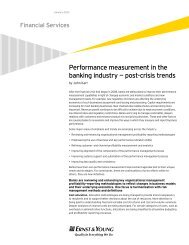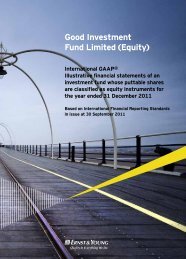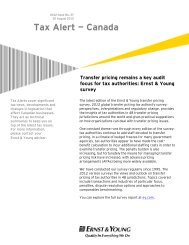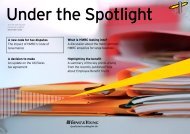Specialty: Insights for the specialty insurance and ... - Ernst & Young
Specialty: Insights for the specialty insurance and ... - Ernst & Young
Specialty: Insights for the specialty insurance and ... - Ernst & Young
Create successful ePaper yourself
Turn your PDF publications into a flip-book with our unique Google optimized e-Paper software.
<strong>Specialty</strong><strong>Insights</strong> <strong>for</strong> <strong>the</strong> <strong>specialty</strong> <strong>insurance</strong> <strong>and</strong> re<strong>insurance</strong> marketIssue 1 | December 2012The growthissueMy five most courageousdecisionsMeeting <strong>the</strong> challenge of change —what’s next <strong>for</strong> <strong>specialty</strong> insurerslooking to achieve growth?Tax leakage: more than a drop in<strong>the</strong> oceanSST versus Solvency II — shining aspotlight on how Swiss companiesare working successfullyTaking a closer look at <strong>the</strong> latestflurry of transactions in <strong>the</strong>London market
In spring 2012, we published our final London <strong>and</strong>Bermuda journal, our main insight <strong>for</strong> <strong>the</strong> <strong>specialty</strong>(re)<strong>insurance</strong> markets. While this new publicationreplaces it, we maintain many of <strong>the</strong> things that workedwell. Indeed, you will notice great similarities between<strong>the</strong>se publications as we present our point of view on<strong>the</strong> most pressing issues facing this industry <strong>and</strong> its keyplayers. However, we’ve changed our focus slightly toreflect <strong>the</strong> increasingly global nature of <strong>specialty</strong>(re)<strong>insurance</strong>: companies face common issuesregardless of <strong>the</strong>ir location <strong>and</strong> <strong>the</strong>re is little certaintyaround how <strong>the</strong> industry will look in five years.As advisors to this market segment, we continue tohelp organizations make sense of this rapidly evolvingenvironment <strong>and</strong> to support our clients whatever<strong>the</strong> future may hold. We’ve <strong>for</strong>med a new integrated<strong>specialty</strong> team with members who work closelytoge<strong>the</strong>r across <strong>the</strong> world to serve this market better.We recognize that a more global approach is requiredto provide truly world-class services.We hope <strong>the</strong> articles in this publication provide youwith some helpful insights.
In this issue ...02Meeting <strong>the</strong> challenge of changeWhat’s next <strong>for</strong> <strong>specialty</strong> insurers lookingto achieve growth? We examine <strong>the</strong> mainfactors influencing strategy <strong>and</strong> driving <strong>the</strong><strong>specialty</strong> sector to seek growth.06Lloyd’s remains as attractive as everThe flurry of transaction activity in <strong>the</strong><strong>specialty</strong> market is set to continue, withseveral <strong>insurance</strong> vehicles remainingattractive acquisition targets.08Financial services ITEM clubeconomic <strong>for</strong>ecastThere is welcome news <strong>for</strong> <strong>specialty</strong> insurerskeen to optimize opportunities in <strong>the</strong> Londonmarkets as <strong>the</strong> latest ITEM <strong>for</strong>ecast <strong>for</strong>financial services sees a return to growth <strong>for</strong><strong>the</strong> UK economy.12Investing in <strong>the</strong> finance function as aprerequisite <strong>for</strong> achieving growthWe examine why it’s important to invest in<strong>the</strong> finance operating model <strong>and</strong> identifywhat companies need to do to realize growthopportunities.18The Swiss Solvency Test versusSolvency IIWe shine a spotlight on <strong>the</strong> similarities <strong>and</strong>differences between <strong>the</strong>se two regimes<strong>and</strong> consider how Swiss companies aresuccessfully working within this framework.22Tax leakage: more than a drop in <strong>the</strong>oceanBetter management of <strong>the</strong> withholding taxcost on cross-border investment incomecould be a quick win to driving improvedper<strong>for</strong>mance.26The benchmarkOur survey uncovers substantialopportunities <strong>for</strong> <strong>specialty</strong> companies toreduce <strong>the</strong>ir costs by trans<strong>for</strong>ming <strong>the</strong>iroperating models <strong>and</strong> provides valuableinsight <strong>for</strong> those being challenged to drivemargins in a sustained soft market.31Key contacts14My five most courageous decisionsRobert Hiscox reveals in his own words someof <strong>the</strong> key decisions that helped to makehis business so successful <strong>and</strong> also outlineswhere he sees <strong>the</strong> future of <strong>the</strong> industry.
WelcomeWelcome to <strong>Specialty</strong>— our new twice yearlypublication <strong>for</strong> <strong>specialty</strong>insurers <strong>and</strong> reinsurers.Clients often ask me, “Howcan I grow my business in asustained soft market?” AsI travel around many of <strong>the</strong><strong>specialty</strong> locations, I hearthis more <strong>and</strong> more, particularly as new capital<strong>and</strong> price competition fur<strong>the</strong>r exacerbate <strong>the</strong>cycle.The tragic events of tropical storm S<strong>and</strong>y, whichcaused so much death <strong>and</strong> destruction in <strong>the</strong>Caribbean <strong>and</strong> Nor<strong>the</strong>ast seaboard, highlight<strong>the</strong> key role <strong>insurance</strong> plays in paying claims tohelp neighborhoods, families <strong>and</strong> businessesget back to normal. However, although somemarket participants expect staggering losses ofUS$20b <strong>and</strong> beyond, this does not appear tobe significant enough to cause hardening of <strong>the</strong>market <strong>and</strong> a spur to growth.There are many differing views on <strong>the</strong> waysto achieve growth in <strong>the</strong>se market conditions;however, most CEOs I speak with predict severalcommon avenues. As you will read, expansionto Asian markets remains a strong opportunity:Hong Kong <strong>and</strong> Singapore offer excellentpotential <strong>for</strong> new capital <strong>and</strong> new business,though <strong>the</strong> infrastructure requirements <strong>and</strong>risk management considerations are very much“front of mind” <strong>for</strong> those with eastern expansionplans. While a change in location footprintis an option, regulatory challenges affect all<strong>specialty</strong> locations, albeit in differing ways. Forexample, while Europe continues to secondguesswhen — or even if — Solvency II will comeinto <strong>for</strong>ce, Hong Kong is trying to anticipate<strong>the</strong> Financial Services Authority’s decision onfund management rebates <strong>and</strong> <strong>the</strong> impact on itseconomic <strong>and</strong> operating models.Given <strong>the</strong> high priority placed on growth by seniorexecutives, our first issue concentrates on this<strong>the</strong>me. What are <strong>the</strong> best options <strong>for</strong> growth?Which markets are <strong>the</strong> most attractive? Whatchanges should be made to operating modelsto facilitate growth? How might companiesinnovate? In <strong>the</strong> series of articles that follow, weseek to address <strong>the</strong>se questions <strong>and</strong> more. Wealso speak with one of <strong>the</strong> industry’s prominentfigures who has grown his business substantiallyin <strong>the</strong> years he has been at <strong>the</strong> helm — RobertHiscox. Robert tells us about <strong>the</strong> most courageousbusiness decisions he has made as leader of hisinternationally successful business <strong>and</strong> also wherehe sees <strong>the</strong> future of <strong>the</strong> market.And finally, on a slightly different note, I’d liketo share my excitement about <strong>the</strong> creation ofour new global <strong>specialty</strong> team. We’ve created anintegrated team across a number of locationswhose remit is to focus solely on <strong>the</strong> businessneeds of <strong>specialty</strong> (re)insurers — companies willbenefit from our more unified global view ofthis market as we bring <strong>the</strong> full weight of ourknowledge to create options <strong>for</strong> <strong>the</strong> most complexof business issues.We hope that this publication will providesome food <strong>for</strong> thought as to how players in <strong>the</strong><strong>specialty</strong> (re)<strong>insurance</strong> markets can differentiate<strong>the</strong>mselves <strong>and</strong> succeed in <strong>the</strong> uncertain timesthat lie ahead.Shaun Craw<strong>for</strong>dGlobal Head of Insurance, <strong>Ernst</strong> & <strong>Young</strong>Issue 1 — December 2012 <strong>Specialty</strong> 1
Article / Growth: future outlookMeeting <strong>the</strong> challengeof changeWhat’s next <strong>for</strong> <strong>specialty</strong> insurers looking toachieve sustainable business growth?Having spoken to a number ofCEOs operating in <strong>the</strong> <strong>specialty</strong><strong>insurance</strong> <strong>and</strong> re<strong>insurance</strong>market, we found that <strong>the</strong>majority believe <strong>the</strong> industry is atan inflection point.The 2012 half-year results of listed <strong>specialty</strong>insurers revealed robust earnings <strong>and</strong> astrong per<strong>for</strong>mance, despite a challengingbackdrop of lower global GDP growth,anemic investment yields <strong>and</strong> <strong>the</strong> nearrecordcatastrophe losses of 2011. Although<strong>the</strong> market has generated strong profits sofar in 2012, growth is proving a significantchallenge. The developed economies of <strong>the</strong>western hemisphere are largely stagnatingor are in low-growth mode <strong>and</strong> will be <strong>for</strong><strong>the</strong> <strong>for</strong>eseeable future, which is severelyrestricting <strong>the</strong> ability of <strong>insurance</strong> carriersto grow with <strong>the</strong>ir existing footprint. Bycontrast, exp<strong>and</strong>ing emerging economiesoffer tantalizing opportunities <strong>for</strong> <strong>the</strong><strong>specialty</strong> market.So what are <strong>the</strong> main factors influencingstrategy <strong>and</strong> driving <strong>the</strong> <strong>specialty</strong> sectorto seek growth? In this article, we outlineour views on likely developments <strong>for</strong> <strong>the</strong><strong>specialty</strong> market in <strong>the</strong> next five years.The pressure to growProfitability from existinglines is not sufficient to beatmarket expectationsAt <strong>the</strong> half year, <strong>the</strong> <strong>specialty</strong> marketdelivered a strong set of results <strong>and</strong>generated a better return on investmentthan o<strong>the</strong>r <strong>insurance</strong> sectors. Theseresults could largely be explained by prioryear reserve releases <strong>and</strong> a benign claimsenvironment. Clearly, <strong>the</strong> second half of<strong>the</strong> year will be affected by tropical stormS<strong>and</strong>y with initial indications showing thatUS primary carriers will be particularly badlyhit: losses are estimated to be US$20b <strong>and</strong>beyond although this is likely to impactearnings <strong>and</strong> not capital. The half-yearresults announcements 1 show that averageearnings were better in 2012 than prioryears <strong>and</strong> that <strong>the</strong> price-to-book multipleshave increased to 1.35x compared with1.15x 2 at <strong>the</strong> start of 2012. In addition, <strong>the</strong>average price-to- earnings ratio of <strong>specialty</strong>insurers comes in at 9.8x, compared with7.7x 2 <strong>for</strong> <strong>the</strong> remaining <strong>insurance</strong> sector.These figures tally with <strong>the</strong> views of <strong>the</strong>majority of market practitioners, withCEOs prioritizing increased underwriting1 <strong>Specialty</strong> insurers listed on <strong>the</strong> LSE.2 Deutsche Bank Markets Research, 8 August 2012.profitability over growth. The common<strong>the</strong>mes identified from our discussionswere a focus on disciplined <strong>and</strong> selectiveunderwriting <strong>and</strong> appropriate pricing <strong>for</strong>risks being written.Despite this positive picture, mostinvestment analysts we speak to recommendholding <strong>specialty</strong> shares ra<strong>the</strong>r than buying.Investors are being urged to show caution,as delivering improved returns from existinglines of business is exceptionally challengingin an environment where rates are notexpected to increase significantly, GDPgrowth is minimal <strong>and</strong> future prior-yearreserve releases are drying up.Regulation favors largercross-border firmsThe current <strong>and</strong> proposed regulatoryenvironment is creating a drive <strong>for</strong> growththat may not be in <strong>the</strong> best interests of <strong>the</strong><strong>specialty</strong> market overall.Firstly, smaller carriers aredisproportionately hurt by regulations,which are <strong>the</strong> same whe<strong>the</strong>r a carrier writesUS$1b of premiums or US$100m. Smallercompanies typically lack <strong>the</strong> scale to absorb<strong>the</strong> additional costs that regulation creates<strong>and</strong> generally have insufficient in-housecapability to implement a plethora ofchanges. We have seen expense ratios riseacross <strong>the</strong> sector (especially among <strong>the</strong>2 <strong>Specialty</strong> Issue 1 — December 2012
smaller players) as a result of both <strong>the</strong> softmarket <strong>and</strong> <strong>the</strong> costs of implementing newregulation. We envision that <strong>the</strong>se smallercarriers will be at a cost disadvantage as wellas a capital disadvantage from a regulatoryst<strong>and</strong>point compared with <strong>the</strong> larger insurers,which will have lower expense ratios as wellas more resources to implement regulatorychange (such as better internal models).Secondly, most regulatory requirementsare effectively discouraging a narrow focuson fewer lines. The ratings agencies turnedbearish on monoline carriers after 2004<strong>and</strong> 2005, when losses from hurricaneshurt a number of pure-play propertycatastrophe (re)insurers. In addition, from acapital perspective, <strong>the</strong> Solvency II regimegives significant credit to (re)insurerswith diversified businesses. We have seena number of carriers pursue growth in“uncorrelated” lines of business to provide<strong>the</strong>m with <strong>the</strong> diversification credit. However,returns have been diluted as <strong>the</strong> carrier maylack <strong>the</strong> underwriting expertise in <strong>the</strong> newareas, or <strong>the</strong> risk association with <strong>the</strong>se newlines may not have been fully understood —e.g., international property treaty <strong>and</strong> <strong>the</strong>losses arising from <strong>the</strong> Thai floods of 2011.Recovery <strong>and</strong> resolution planning is anoteable exception. These changesencourage firms to focus on fewer lines <strong>and</strong>simplify <strong>the</strong>ir corporate structures.Larger firms can negotiatemore favorable terms frombrokers<strong>Specialty</strong> insurers, including Lloyd’s, haverecognized <strong>the</strong> challenge posed by <strong>the</strong>largest brokers’ dominance. 3 The largestthree brokers (Aon, Marsh <strong>and</strong> Willis) haveplaced just over half of <strong>the</strong> business acrossall lines, <strong>and</strong> in re<strong>insurance</strong> <strong>the</strong>y control75%. 4Several of <strong>the</strong> CEOs who we spoke tohighlighted <strong>the</strong>ir dependency on <strong>the</strong>“big three” brokers <strong>and</strong> said that <strong>the</strong>concentration of power with <strong>the</strong>se playersleaves <strong>the</strong>m vulnerable. While larger carriersmay have significant market share in certainlines, which <strong>the</strong>y can leverage to resist<strong>the</strong> negotiating powers of brokers, smallerplayers are particularly vulnerable <strong>and</strong> lack<strong>the</strong> might to prevent <strong>the</strong>ir underwritingmargins from being eroded. The implicationof this is that <strong>the</strong> smaller carriers will need topursue scale to counteract <strong>the</strong> might of <strong>the</strong>large brokers.3 Lloyd’s 2011 Annual Report <strong>and</strong> Accounts underStrategic Review.4 Insider 16 July 2012, The biggest 10 brokers place justover three-quarters of business across all lines; inre<strong>insurance</strong> <strong>the</strong>y control 95.7%.5 Aon Benfield, 2012 June <strong>and</strong> July Renewals Update.6 Aon Benfield, 2012 June <strong>and</strong> July Renewals Update— Between 2010 <strong>and</strong> Q1 2012, <strong>the</strong> re<strong>insurance</strong> capacityhas remained unchanged at US$470b, <strong>and</strong> <strong>the</strong> <strong>insurance</strong>capacity has increased by 5%.The underwriting cycle mayflattenBetween 2008 <strong>and</strong> 2010, re<strong>insurance</strong>capacity increased by 35% from US$342b toUS$470b <strong>and</strong> <strong>insurance</strong> capacity increasedby 46%. 5 Given <strong>the</strong> severity of <strong>the</strong> majorlosses of 2010 <strong>and</strong> 2011, we would expectsome of this capacity to have been depleted.However, it has remained stable during thisperiod. 6 The increase in it from 2008 to2010 <strong>and</strong> <strong>the</strong> effect of <strong>the</strong> financial crisisof 2008 is not a coincidence. Capacityentered at <strong>the</strong> start of <strong>the</strong> crisis as investors,including large pension funds <strong>and</strong> privateequity (PE) firms, sought alternate waysto boost yields amid volatile markets <strong>and</strong>anemic global growth. These investors wereattracted by <strong>the</strong> fact that <strong>the</strong> <strong>insurance</strong> cycleis uncorrelated to <strong>the</strong> general economiccycle.The way this new capacity has been deployedshows a changing dynamic in <strong>the</strong>(re)<strong>insurance</strong> market. The major losses of<strong>the</strong> last two years did not result in a “class of2010-2011” like in 2001 <strong>and</strong> 2005. Instead,much of this capacity is being channeledthrough sidecars, cat bonds <strong>and</strong> investmentlinkedsecurities, as evidenced by <strong>the</strong> factthat <strong>the</strong> Bermuda Monetary Authoritylicensed 23 special purpose insurers in 2011.Never be<strong>for</strong>e has <strong>the</strong>re been such flexibilityin getting capital to <strong>the</strong> market <strong>and</strong> oneconsequence of this might be <strong>the</strong> flatteningIssue 1 — December 2012 <strong>Specialty</strong> 3
Meeting <strong>the</strong> challenge of changeof <strong>the</strong> rating cycle. As a result, it may be difficult to rely on <strong>the</strong>strategy of capitalizing on <strong>the</strong> cycle <strong>and</strong> gearing up in a hard market<strong>and</strong> may mean that being smaller <strong>and</strong> more nimble is no longer asadvantageous.Scale can offset downward pricing pressureIn <strong>the</strong> current market, with surplus capacity <strong>and</strong> supply outstrippingdem<strong>and</strong>, price pressure will continue. Unless a meaningful amount ofcapacity exits <strong>the</strong> market, underwriting margins will continue to beunder pressure <strong>and</strong> management will turn its attention to lowering<strong>the</strong> expense ratio to boost returns. We have already seen a number ofcarriers implement cost reduction programs, while several o<strong>the</strong>rs arelooking to grow <strong>and</strong> gain scale to defray <strong>the</strong>ir fixed costs over a largepolicy base.The options <strong>for</strong> achieving growthTaking market share through M&A is a wellwornpathOne option available to carriers to achieve scale is through M&A. Inrecent months, <strong>the</strong>re has been significant speculation concerning<strong>the</strong> prospect of M&A activity in <strong>the</strong> <strong>specialty</strong> markets. Severaltransactions have already been completed, <strong>and</strong> we underst<strong>and</strong> thato<strong>the</strong>rs are close to completion. 7Fur<strong>the</strong>r activity is rumored, particularly in London <strong>and</strong> Bermuda,<strong>and</strong> unlisted privately owned companies also present interestingopportunities. In addition, <strong>the</strong> significant cash funds available to PEplayers means fur<strong>the</strong>r PE buyouts are a credible possibility. Meanwhile,insurers from <strong>the</strong> US <strong>and</strong> Asia are facing similar challenges, includinglack of organic growth in <strong>the</strong>ir home countries, <strong>and</strong> as a result areincreasingly showing an interest in access to <strong>the</strong> Lloyd’s plat<strong>for</strong>m.But getting it right is a challengeAlthough most CEOs would consider inorganic growth strategies,numerous acquisitions or mergers have not delivered value <strong>for</strong> allstakeholders. In our experience, common challenges include:► Insufficient knowledge <strong>and</strong> underst<strong>and</strong>ing of <strong>the</strong> underlying bookof business (<strong>and</strong> corresponding reserves) being purchased► Estimating correctly <strong>the</strong> economies of scale that can be achievedby combining two <strong>specialty</strong> businesses► Execution of post-integration plans <strong>and</strong> a good underst<strong>and</strong>ing of<strong>the</strong> cultural differences between organizations. The importance ofthis cannot be underestimated; many a transaction has destroyedvalue as a result of management failing to find a way to meld <strong>the</strong>best of both <strong>the</strong> acquirer <strong>and</strong> acquired businesses’ cultures <strong>and</strong>working practices.► Differences in internal IT systems, control environment <strong>and</strong>governance frameworks — <strong>for</strong> example, when managingexpectations of dominant individuals.There<strong>for</strong>e, a good alternative avenue to achieve growth couldbe to pursue <strong>the</strong> sale <strong>and</strong> purchase of specific lines of businessor to acquire a team of people. Key differences will still need tobe addressed: <strong>the</strong> team should be integrated into <strong>the</strong> business,cultural differences identified <strong>and</strong> harmonised, <strong>and</strong> degrees offreedom communicated to <strong>the</strong> new team. It appears that <strong>the</strong>re areopportunities to pursue this alternative avenue, especially withincreasing private equity (PE) involvement with <strong>the</strong> <strong>Specialty</strong> sector.PE players pride <strong>the</strong>mselves in being innovative with <strong>the</strong> businesses<strong>the</strong>y own, <strong>and</strong> this could result in rationalization of books of businessor <strong>the</strong> splitting or combining of businesses with a view to releasing<strong>the</strong> “trapped” value in a company.A new product development strategy is oftenoverlookedTaking new products to market is a viable option <strong>for</strong> growth, but onethat does not appear to be on <strong>the</strong> agenda <strong>for</strong> most <strong>specialty</strong> firms.While notable exceptions exist, such as successes around cyber liability,in general it appears that companies lack <strong>the</strong> appetite to invest time,money <strong>and</strong> resources in developing new or non-traditional products toserve new industries. A number of CEOs who we spoke to agreed thatinnovation (particularly product innovation) was not a key strength of<strong>the</strong> <strong>specialty</strong> market. At <strong>the</strong> same time, <strong>the</strong> constantly changing natureof <strong>the</strong> world’s economy provides a wealth of dem<strong>and</strong> <strong>for</strong> new riskmanagement products.Moving into emerging markets is attractive …It is well publicized that GDP growth in emerging markets hassignificantly outpaced that of developed economies in recent years,<strong>and</strong> we have seen <strong>the</strong> <strong>specialty</strong> market take advantage of this. Forinstance, when capacity entered <strong>the</strong> market between 2007 <strong>and</strong> 2011,Lloyd’s saw a 5% increase in its business written in Central Asia <strong>and</strong>Asia Pacific. By contrast, during <strong>the</strong> same period, UK business writtenat Lloyd’s decreased by 6%. 8However, <strong>the</strong> decrease of <strong>the</strong> UK segment is not a result of lowerpremium volumes — on <strong>the</strong> contrary, premiums have grown year onyear, albeit less than in emerging markets. Indeed, <strong>the</strong> volume ofbusiness written within countries in Latin <strong>and</strong> Central America, CentralAsia <strong>and</strong> Asia Pacific has grown by 105% over <strong>the</strong> last five years,compared with growth of 31% within <strong>the</strong> US, Canada, UK <strong>and</strong> Europe.7 Recent transactions completed or near completion include: Chaucer & Hanover Group (April2011), Omega <strong>and</strong> Canopius (April 2012), Hardy & CNA (July 2012), Sea Bright Enstar(August 2012), Flagstone Re Validus (August 2012).8 Society of Lloyd’s segment analysis — 2007-119 Semiannual report, World Bank.4 <strong>Specialty</strong> Issue 1 — December 2012
Article / Growth: future outlook… <strong>and</strong> <strong>the</strong> best opportunities are in <strong>the</strong> tigereconomiesLloyd’s has been vocal <strong>and</strong> proactive about its intentions to grow inLatin America <strong>and</strong> Asia by streng<strong>the</strong>ning its distribution channels in<strong>the</strong>se areas. The change in <strong>the</strong> composition of its book supports thisto some extent. In addition, <strong>the</strong> series of natural catastrophes in Asiahas helped to raise risk awareness <strong>and</strong> prompt corporations to seekincreased <strong>insurance</strong>.Most CEOs recognize that <strong>the</strong> emerging economies present a greatopportunity, although this will not be an option <strong>for</strong> everyone. In ourview:► Great opportunities exist to create hubs in <strong>the</strong> “tigereconomies” in <strong>the</strong> Far East. This area is an increasingly excitingplace to be, with access to a number of countries. We have seensome <strong>specialty</strong> players open offices, recruit local talent <strong>and</strong> investin building <strong>and</strong> streng<strong>the</strong>ning distribution channels in <strong>the</strong> region.This has enabled access to new business <strong>and</strong>, with more <strong>and</strong>more players increasing <strong>the</strong>ir presence, it will provide <strong>the</strong> abilityto compete with existing large insurers in that region by writingrisks on a subscription basis. Over time, <strong>the</strong> view that a largeproportion of <strong>specialty</strong> business comes to London will diminish,<strong>and</strong> we believe <strong>the</strong>se hubs will attract business from across Asia.► Brazil presents ano<strong>the</strong>r great opportunity <strong>and</strong> providesgood access to <strong>the</strong> rest of Latin America. Brazil is one of<strong>the</strong> fast-growth emerging economies, <strong>and</strong> <strong>the</strong> entire region ofLatin America is predicted to grow by 3.8%–4% 9 in 2013. Lloyd’shas opened a franchise in Brazil <strong>and</strong> plans to streng<strong>the</strong>n itsdistribution channels. The 2016 Olympic Games in Rio de Janeiropresents some short-term opportunities, <strong>and</strong> is Brazil’s (<strong>and</strong> LatinAmerica’s) opportunity to take center stage <strong>and</strong> showcase to <strong>the</strong>world <strong>the</strong> investment opportunities available.► India <strong>and</strong> China also present enormous growth opportunities,but <strong>the</strong> political, regulatory, legal, social <strong>and</strong> culturaldynamics are extremely challenging. For example, legislationprevents full control of a company, <strong>and</strong> a local partner is required— a particularly delicate balancing act <strong>for</strong> carriers that wish toensure <strong>the</strong>ir intellectual property is protected. We believe thatboth substantial investment <strong>and</strong> a long time frame is needed<strong>for</strong> a new entrant to <strong>the</strong> Chinese <strong>and</strong> Indian <strong>specialty</strong> <strong>insurance</strong>markets to take full advantage of <strong>the</strong> opportunities available.Exp<strong>and</strong>ing into new markets in emerging economies offers clearattractions but is not without risk. Indeed, several CEO’s in <strong>the</strong>market have avoided <strong>the</strong> emerging economies <strong>and</strong> instead arefocusing on developed economies with very large, mature <strong>insurance</strong>markets. In many ways, doubling <strong>the</strong>ir market share from 0.5% to1% of a developed economies’ <strong>insurance</strong> market can be easier as <strong>the</strong>competition, ways of doing business, legal system, <strong>and</strong> culture are allknown <strong>and</strong> familiar.Our view is that carriers should simplify <strong>the</strong>ir business models <strong>and</strong>focus on fewer, narrower lines <strong>and</strong> fewer locations. A focus onsimplification would enable carriers to concentrate on <strong>the</strong>ir corestrengths <strong>and</strong> free management from being distracted by peripheralclasses of business which are “nearly breaking even” or “just aboutto take off on a growth spurt”. Operating in fewer locations wouldalso bring lower costs with less people issues, <strong>and</strong> systems should bemore easily aligned with business processes.<strong>Specialty</strong> in <strong>the</strong> futureWe see this as an exciting yet challenging time <strong>for</strong> <strong>specialty</strong> insurersas <strong>the</strong>y enter new markets <strong>and</strong> pursue new strategies. We predict:► London, Bermuda, Switzerl<strong>and</strong> <strong>and</strong> <strong>the</strong> US will continue to be<strong>the</strong> most prominent locations in this market, however we see <strong>the</strong>emergence of a competitive <strong>and</strong> sizeable local hub in Asia.► Winners in <strong>the</strong> market will be those pursuing a strategy of growthby taking market share in developed economies or increasingmarket penetration in emerging economies. The complexity oftrying to achieve both will be too difficult.► The concentration of power <strong>and</strong> dominance of <strong>the</strong> brokers willcontinue, with fur<strong>the</strong>r consolidation increasing <strong>the</strong> market shareof <strong>the</strong> largest brokers.► The race <strong>for</strong> talent, in a market where most CEOs recognize<strong>the</strong>re is a shortage, will result in wage inflation, especially <strong>for</strong>specialized skills. This, along with <strong>the</strong> costs of compliance, placesmore pressure on <strong>the</strong> expense ratio.► Building a br<strong>and</strong> new franchise will be more challenging. Withsignificant barriers to entry, regulatory costs <strong>and</strong> concentrationof brokers in distribution, significant scale will be required todeliver <strong>the</strong> returns dem<strong>and</strong>ed by <strong>the</strong> market.► Building <strong>the</strong> franchises of today from scratch will no longer bepossible. With significant barriers of entry, regulatory costs <strong>and</strong>scale required to deliver returns, <strong>the</strong> spirit of entrepreneurship,which is what built this market, will be lost.AuthorsPaul Cooper (pcooper@uk.ey.com) is a Partner with <strong>Ernst</strong> & <strong>Young</strong> LLP (UK)who works on a range of audit, advisory <strong>and</strong> transactions projects <strong>for</strong> <strong>specialty</strong><strong>insurance</strong> clients in London, Bermuda <strong>and</strong> New York.Richard Battersby (rbattersby@uk.ey.com) is a Partner working across <strong>the</strong>same locations in transaction advisory services, <strong>and</strong> Shubhendra Bobby Swarup(sswarup@uk.ey.com) is a Senior Manager in <strong>the</strong> London-based audit team.Issue 1 — December 2012 <strong>Specialty</strong> 5
Article / Growth: M&A activityFour transactions across 2011 <strong>and</strong> 2012 (upto October 2012) related to <strong>the</strong> acquisitionsof Lloyd’s plat<strong>for</strong>ms by overseas insurerswhere <strong>the</strong> respective acquirers werewilling to pay a significant premium <strong>for</strong> <strong>the</strong>respective plat<strong>for</strong>ms. The Lloyd’s plat<strong>for</strong>m,which includes access to underwritinglicenses in over 75 jurisdictions, is anattractive proposition to many buyers,particularly those who haven’t achievedorganic growth in <strong>the</strong> current ratingenvironment. CNA Financial’s Chairman <strong>and</strong>CEO, Tom Motamed, noted in reference to itsacquisition of Hardy, “With its access to <strong>the</strong>US$35 billion Lloyd’s marketplace, Hardy willprovide a solid plat<strong>for</strong>m <strong>for</strong> profitable growth<strong>and</strong> an attractive opportunity <strong>for</strong> CNA todeploy capital.”Lloyd’s operations have proved popular inrecent years, with <strong>the</strong> number of LondonStock Exchange-listed Lloyd’s insurersfalling to five following Apollo <strong>and</strong> CVCprivate equity’s acquisition of Brit, TheHanover Group’s acquisition of Chaucer,CNA’s acquisition of Hardy <strong>and</strong> Canopius’stie-up with Omega. Since 2007, a majorityof Lloyd’s listed vehicles, including Atrium,Kiln, Heritage, Brit <strong>and</strong> Chaucer, havebeen acquired. Novae, <strong>the</strong> smallest of <strong>the</strong>remaining listed Lloyd’s businesses by marketcapitalization, <strong>and</strong> once a suitor in <strong>the</strong> racesto acquire Chaucer <strong>and</strong> Omega, remains anoften-discussed potential takeover target in<strong>the</strong> trade press.As a market, Lloyd’s has been managingits capacity carefully, with <strong>the</strong> number ofsyndicate start-ups approved by Lloyd’sfalling from nine in both 2008 <strong>and</strong> 2009 tothree in 2010 <strong>and</strong> 2011. This has effectivelyrestricted new entrants from gaining accessto <strong>the</strong> market through acquisitions or viaa slower process of establishing a turnkeyoperation.Following acquisitions of a number oflisted players since 2007, some privatelyowned Lloyd’s <strong>insurance</strong> vehicles havebeen discussed in <strong>the</strong> trade press recentlyas ei<strong>the</strong>r acquirers or targets. There are anumber of potential transactions in process,<strong>and</strong> we expect some of <strong>the</strong>m to be completedin <strong>the</strong> next 12–24 months.Looking fur<strong>the</strong>r afield, Bermuda has seenan influx of additional capital over <strong>the</strong> last18 months, with substantial investmentsbeing made in side cars, hedge fund backedvehicles <strong>and</strong> o<strong>the</strong>r <strong>insurance</strong>-linked assets.This capital looks set to benefit from apositive return in 2012 albeit, with <strong>the</strong>impact of S<strong>and</strong>y yet to be determined.It will be interesting to see what happensto some of this capital if rates softensignificantly, if substantial cat losses areincurred, if markets improve <strong>and</strong> generatealternative investment opportunities <strong>for</strong>hedge funds, or if a combination of <strong>the</strong>sefactors occurs.Market conditions remain conducive tofur<strong>the</strong>r transaction activity in <strong>the</strong> Lloyd’smarket, <strong>and</strong> several <strong>insurance</strong> vehiclesremain attractive acquisition targets <strong>for</strong> <strong>the</strong>purposes of gaining access to <strong>the</strong> Lloyd’splat<strong>for</strong>m.6 <strong>Specialty</strong> Issue 1 — December 2012
Lloyd’s remainsas attractive as ever …We have seen a flurry of transaction activity in <strong>the</strong> <strong>specialty</strong>market since <strong>the</strong> early part of 2011. Market conditions havebeen conducive <strong>for</strong> M&A activity, given <strong>the</strong> capital availablewithin insurers <strong>and</strong> private investors, continued softness inrates <strong>and</strong> low investment yields.An overview of recent activityDate Buyer Target ConsiderationUS$mNTA multipleAugust 2012 Validus Flagstone Re 623 0.7xAugust 2012 Enstar SeaBright 252 0.7xAugust 2012 Tower Canopius Bermuda 240-290 1.0xJuly 2012 CNA Hardy 255 1.5xMay 2012 Tokio Marine Delphi 2,700 1.5xApril 2012 QBE Brit UK 63 n/aApril 2012 ANV Flagstone Re at Lloyd’s 210 1.3xApril 2012 Canopius Omega 255 0.9xMarch 2012 Alleghany Transatlantic Re 3,400 0.8xMarch 2012 Goldman Sachs Ariel Re n/a n/aMarch 2012 Arch Ariel Credit <strong>and</strong> Surety n/a n/aJanuary 2012 Tawa/Paraline/Skuld Whittington n/a n/aSeptember 2011 Ryan <strong>Specialty</strong> Jubilee 57 3.0xMay 2011 Apollo/CVC Brit 1,423 1.0xApril 2011 The Hanover Group Chaucer 510 1.3xSource: <strong>Ernst</strong> & <strong>Young</strong>AuthorJames Aldridge (jaldridge@uk.ey.com) is a Directorwith <strong>Ernst</strong> & <strong>Young</strong> LLP (UK) <strong>and</strong> works in <strong>the</strong> Londonbasedtransaction advisory services team.Issue 1 — December 2012 <strong>Specialty</strong> 7
Article / Growth: UK economyAutumn 2012Financial servicesITEM club economic<strong>for</strong>ecastThere is welcome news <strong>for</strong> <strong>specialty</strong> insurers keen to optimize opportunities in <strong>the</strong> London markets as <strong>the</strong>latest ITEM <strong>for</strong>ecast <strong>for</strong> financial services sees a return to growth <strong>for</strong> <strong>the</strong> UK economy in <strong>the</strong> second half of2012. GDP is down only 0.2% on <strong>the</strong> year as a whole. Growth <strong>the</strong>n picks up to 1.2% next year <strong>and</strong> to 2.4% in2014 <strong>and</strong> 2015. The <strong>for</strong>ecast includes a mild recovery in consumption, thanks to falling inflation <strong>and</strong> risingemployment. CPI inflation is expected to ease back into line with its target over <strong>the</strong> winter. In this article,we summarize <strong>the</strong> latest findings <strong>and</strong> how <strong>the</strong>y affect general <strong>insurance</strong> (property <strong>and</strong> casualty) companies.After falling 0.9% in 2011, consumer spending is expected to grow by0.6% in 2012 <strong>and</strong> by 0.8% in 2013. Although this is an improvement,it is still weak by historical st<strong>and</strong>ards. The housing market will benefitfrom rising real incomes <strong>and</strong> consumer confidence, as well as <strong>the</strong>easing of funding pressures on <strong>the</strong> mortgage market. We expecthousing transactions to fall to <strong>the</strong>ir lowest levels this autumn be<strong>for</strong>estarting to recover in 2013, with house prices set to follow. Therecovery will be slow, however, with transactions at <strong>the</strong> end of 2016still 39% below <strong>the</strong> levels reached in 2007. The gradual turn in <strong>the</strong>housing market will be assisted by a modest improvement in <strong>the</strong>availability of mortgages. UK banks have reduced <strong>the</strong>ir borrowingfrom overseas banks <strong>and</strong> <strong>the</strong> Bank of Engl<strong>and</strong> <strong>and</strong> can now usegrowing savings deposits to boost lending to <strong>the</strong> private sector. TheFunding <strong>for</strong> Lending Scheme <strong>and</strong> revival of <strong>the</strong> securities market willprovide fur<strong>the</strong>r support.However, <strong>the</strong> improved outlook <strong>for</strong> <strong>the</strong> consumer is offset by aworsening outlook <strong>for</strong> exports. Short-term prospects remain fragile,with <strong>the</strong> Eurozone likely to slip fur<strong>the</strong>r into recession <strong>and</strong> signs of aslowdown in <strong>the</strong> US <strong>and</strong> emerging markets like China <strong>and</strong> India. Butwe are more optimistic about prospects fur<strong>the</strong>r out, given <strong>the</strong> USFederal Reserve’s announcement of additional quantitative easing<strong>and</strong> <strong>the</strong> European Central Bank’s announcement of a new bondbuyingprogram. The willingness of Saudi Arabia to turn on <strong>the</strong>taps, too, should prevent higher oil prices from holding back growth.Providing that <strong>the</strong> Eurozone remains intact <strong>and</strong> <strong>the</strong> US negotiates its“fiscal cliff” successfully, world trade <strong>and</strong> exports should pick up againnext year. Business investment is unlikely to pick up until domestic<strong>and</strong> overseas dem<strong>and</strong> recovers more convincingly, however. Sparecapacity <strong>and</strong> risk aversion are holding back investment, despite verystrong cash flows enjoyed by UK plc. We are <strong>for</strong>ecasting increasesof 2.3% in 2012 <strong>and</strong> 3.9% in 2013– very modest by <strong>the</strong> st<strong>and</strong>ards ofprevious recoveries.The economic environment remains extremely risky. Policy-makersin <strong>the</strong> Eurozone have vowed to do what it takes to hold <strong>the</strong> systemtoge<strong>the</strong>r, but fur<strong>the</strong>r fiscal austerity is still planned <strong>and</strong> progresstoward a banking union is slow. The US fiscal cliff is looming, <strong>and</strong>emerging markets are slowing more than previously expected.Moreover, this summer saw yet ano<strong>the</strong>r example of extreme wea<strong>the</strong>raffecting food <strong>and</strong> o<strong>the</strong>r world markets. Never<strong>the</strong>less, some upsiderisks are now emerging. The world’s largest central banks haveproved adept at dealing with tail risk, <strong>and</strong> <strong>the</strong>ir latest moves are verysupportive. In <strong>the</strong> UK, <strong>the</strong>re is a chance that <strong>the</strong> credit famine mightbe nearing its end, at least in <strong>the</strong> mortgage market, which couldresult in a much stronger bounce in <strong>the</strong> housing market <strong>and</strong> <strong>the</strong> highstreet than we currently envision. Similarly, our <strong>for</strong>ecasts <strong>for</strong> exports<strong>and</strong> investment would need to be revised upward if <strong>the</strong> uncertaintyabout <strong>the</strong> Eurozone was convincingly resolved.Table 1: <strong>for</strong>ecasts of <strong>the</strong>UK economyAnnual percentage changes unless specified2011 2012 2013 2014 2015 2016GDP 0.9 –0.2 1.2 2.4 2.4 2.4Consumer prices 4.5 2.8 2.1 2.0 2.0 2.0Average earnings 2.6 2.0 2.8 3.2 3.9 4.0Unemployment rate (%) 4.7 4.8 4.9 4.5 4.1 3.8Government net borrowing (% of GDP) 8.2 6.7 6.7 5.0 3.5 1.9Three-month interbank rate (%) 0.9 0.9 0.8 1.6 2.5 3.5Effective exchange rate 79.9 83.2 84.2 83.6 81.8 79.4Source: ITEM8 <strong>Specialty</strong> Issue 1 — December 2012
Key summary <strong>for</strong> general insurersChart 1.1: UK <strong>insurance</strong> industry profitsThe combination of low interest rates, higher hedging costs, lowerbusiness volumes <strong>and</strong> more onerous capital requirements is provingto be a challenging environment <strong>for</strong> uk <strong>insurance</strong> companies. Inresponse, management remains focused on cost cutting <strong>and</strong> processre-engineering. M&A activity will continue, with <strong>the</strong> aim of reducingcapacity <strong>and</strong> improving topline growth. Property <strong>and</strong> casualty<strong>insurance</strong> prices need to rise <strong>and</strong> annuity rates need to fall in order torebuild profitability. The benefits of restructuring are already visiblein a rise in profit margins from a low of -0.3% in 2009 to 3.2% inQ2 2012.Although margins are now back above <strong>the</strong>ir historical average of2.7%, <strong>the</strong>y are still around one percentage point below <strong>the</strong> levelprevailing be<strong>for</strong>e <strong>the</strong> financial crisis. Improved margins will help<strong>the</strong> contraction in profits slow to 9.5% in 2012 from 31% in 2011.We <strong>the</strong>n expect profits to start recovering in 2013 as nominal GDPgrowth doubles to 4.1%, boosting business volumes <strong>and</strong> making pricerises easier to achieve. The expected 7.1% rise in equity prices willalso support investment returns. Even allowing <strong>for</strong> expected growthof almost 19% in 2013, profits will remain about 25% below <strong>the</strong>£7.8b peak hit in 2010 <strong>and</strong> are not expected to exceed it until 2017(Chart 1.1).b9.08.07.06.05.04.03.02.01.00.0–1.01981Source: ITEM19861991199620012006Forecast20112016Issue 1 — December 2012 <strong>Specialty</strong> 9
FS ITEM Club economic outlook <strong>for</strong> financial services — autumn 2012In <strong>the</strong> near term, <strong>the</strong> UK non-life-<strong>insurance</strong> business will be affectedby weakness in both <strong>the</strong> housing market <strong>and</strong> new car sales (Chart1.2). Slow household income growth <strong>and</strong> credit constraints mean thatwe expect house prices to decline by 0.7% in 2012 <strong>and</strong> <strong>the</strong>n rise byjust 2.3% in 2013. The same factors mean that we expect new carregistrations to decline by 1.2% in 2012 <strong>and</strong> <strong>the</strong>n rise by just 0.5% in2013. As a result, we expect non-life premium growth of just 1.4%in 2012. Corporate business should be a source of support, with <strong>the</strong>number of companies expected to grow by 9% in 2012 <strong>and</strong> 10% in2013. After that, as <strong>the</strong> economic recovery streng<strong>the</strong>ns, premiumgrowth should rise to 3%–6% between 2013 <strong>and</strong> 2016.Chart 1.2: car registrations <strong>and</strong> property transactions3000ForecastThous<strong>and</strong>s2500Car registrations200015001000Property transactions50001990 1993 1996 1999 2002 2005 2008 2011 2014Source: ITEM/Haver AnalyticsTable 2: <strong>insurance</strong> 2011 2012 2013 2014 2015 2016Non-life gross premium (£b) 73 74 77 80 85 89% year 5.9 1.4 3.6 4.7 5.5 5.5Non-life gross claims payments (£b) 36 37 38 38 39 40Paid claims ratio (%) 49 50 50 50 50 50Net profit (£b) 5.4 4.9 5.8 6.7 7.3 7.7Source: ITEM10 <strong>Specialty</strong> Issue 1 — December 2012
Article / Growth: UK economyTable 3: <strong>for</strong>ecast <strong>for</strong> <strong>the</strong> UK economy2011 2012 2013 2014 2015 2016Macro variablesNominal GDP growth (%) 3.6 2.2 4.1 5.4 5.0 5.8Real GDP growth (%) 0.9 –0.2 1.2 2.4 2.4 2.4CPI (% yoy) 4.5 2.8 2.1 2.0 2.0 2.0Labor marketTotal employment (thous<strong>and</strong>s) 29,166 29,493 29,779 30,059 30,374 30,709Employment in manufacturing (thous<strong>and</strong>s) 2,524 2,507 2,485 2,465 2,442 2,422Employment in non-manufacturing (thous<strong>and</strong>s) 23,540 23,765 24,050 24,429 24,844 25,270Unemployment (thous<strong>and</strong>s) 2,564 2,604 2,646 2,532 2,390 2,253DemographicsPopulation (thous<strong>and</strong>s) 63,005 63,479 63,923 64,342 64,753 65,159Population of working age (thous<strong>and</strong>s) 39,188 39,488 39,774 40,042 40,301 40,546Population, 65+ (thous<strong>and</strong>s) 12,072 12,143 12,189 12,215 12,228 12,234ConsumersNominal personal disposable income (% yoy) 3.1 3.9 3.9 3.9 4.7 4.4Gross household financial wealth (£b) 4,284 4,516 4,693 4,872 5,063 5,206Personal loans outst<strong>and</strong>ing (£b) 151 152 155 159 166 174Credit card lending outst<strong>and</strong>ing (£b) 56 54 54 56 59 64Personal insolvencies (thous<strong>and</strong>s) 142 134 129 118 100 84MotoringCar registrations (thous<strong>and</strong>s) 1,941 1,918 1,927 1,969 2,114 2,259Housing marketHouse prices (% yoy) –2.6 –0.7 2.3 4.5 5.7 5.5Number of households (thous<strong>and</strong>s) 26,204 26,386 26,569 26,754 26,940 27,127Property transactions (thous<strong>and</strong>s) 883 916 926 994 1,073 1,147Mortgage marketGross mortgage lending (£b) 141 144 143 166 199 238Net mortgage advances (£b) 10 8 3 18 35 48Number of mortgages approved 593,143 592,604 596,771 640,755 700,028 763,600Total number of mortgages (thous<strong>and</strong>s) 11,260 11,265 11,329 11,409 11,501 11,603Corporate sectorNew companies (% active companies) 0.19 0.24 0.25 0.21 0.19 0.20Insolvencies (% active companies) 0.0079 0.0079 0.0078 0.0078 0.0077 0.0077Total number of companies 2,375,315 2,590,540 2,846,484 3,008,628 3,101,237 3,194,717Company profits (£b) 323 318 334 353 367 374Financial variables3-month interbank rate (%) 0.9 0.9 0.8 1.6 2.5 3.520-year government bond yields (%) 3.1 1.9 2.1 2.9 3.7 4.2FTSE All-Share (% yoy) 2.6 2.0 7.1 13.6 10.2 7.8Source: ITEMThe ITEM Club Outlook <strong>for</strong> Financial Services is a companion to<strong>the</strong> main ITEM Club <strong>for</strong>ecast launched to examine in more detail<strong>the</strong> implications of <strong>the</strong> ITEM Club’s economic projections <strong>for</strong> <strong>the</strong>health of <strong>the</strong> UK financial sector.<strong>Ernst</strong> & <strong>Young</strong> is <strong>the</strong> sole sponsor of <strong>the</strong> ITEM Club, which is<strong>the</strong> only non-governmental economic <strong>for</strong>ecasting group to use<strong>the</strong> HM Treasury model of <strong>the</strong> UK economy. Its <strong>for</strong>ecasts areindependent of any political, economic or business bias.Issue 1 — December 2012 <strong>Specialty</strong> 11
Article / Growth: finance systemsInvesting in <strong>the</strong> financefunction as a prerequisite <strong>for</strong>achieving growthMany <strong>specialty</strong> (re)insurers take great pride in being highly entrepreneurial <strong>and</strong> able torespond quickly to emerging opportunities. Companies pursuing growth do so ei<strong>the</strong>r bymergers <strong>and</strong> acquisition or by exp<strong>and</strong>ing <strong>the</strong> business through new products, offices,locations <strong>and</strong> teams.Management, not unreasonably, expectsintegrating a new business operation intoexisting finance processes <strong>and</strong> systems tobe as easy as “plug <strong>and</strong> play.” However,regardless of <strong>the</strong> strategy pursued, <strong>the</strong>experience of many <strong>specialty</strong> (re)insurers isthat growth just adds cost <strong>and</strong> complexitywithout realizing <strong>the</strong> desired back-office costsynergies <strong>and</strong> economies of scale.For example, as organizations groworganically over time, local financeteams customize processes <strong>and</strong> bolt oncustom-made applications to meet localrequirements. Existing corporate systemsthat were appropriate <strong>for</strong> a smaller financeorganization become a limiting factor <strong>for</strong>larger ones — an inability to provide granularanalysis <strong>and</strong> reporting or to support internalrestructuring are key issues. Internationalexpansion brings <strong>the</strong> additional challengesof operating in multiple currencies, requiringseamless translation <strong>and</strong> revaluationprocesses as well as intercompany servicecharges <strong>and</strong> allocations.Organizations that grow through mergers<strong>and</strong> acquisitions experience a different set ofissues. Many firms choose not to integrateacquisitions operationally. The acquiredcompany continues to operate its existingprocesses <strong>and</strong> systems, mapping financialresults to <strong>the</strong> new parent’s chart of accounts<strong>for</strong> external reporting <strong>and</strong> retaining <strong>the</strong>irinternal management in<strong>for</strong>mation. Evenwhere a corporate general ledger is deployedacross <strong>the</strong> business, <strong>the</strong> existence of multiplelegacy underwriting plat<strong>for</strong>ms can result innumerous challenges. The most prominentissues relate to <strong>the</strong> quality, completeness<strong>and</strong> consistency of underwriting data takenfrom multiple sources, which can resultin considerable excess work to normalizedata <strong>for</strong> reporting or to analyze to <strong>the</strong> levelrequired <strong>for</strong> management reporting.Successful growth requires efficient <strong>and</strong>effective, streamlined support functions thathave <strong>the</strong> flexibility to respond to businesschange. The majority of <strong>the</strong> industry needsto make a real step change in order to realizegrowth opportunities. However, we are awareof a number of companies that are launchingmajor process improvement initiatives <strong>and</strong>large-scale IT implementations to address<strong>the</strong>se challenges.What does good look like?An effective, flexible <strong>and</strong> scalable financefunction has <strong>the</strong> following characteristics:► Processes should be st<strong>and</strong>ardized <strong>and</strong>streamlined <strong>and</strong> procedures supportedby common policies <strong>and</strong> strong financialcontrols. Process st<strong>and</strong>ardization c<strong>and</strong>eliver significant efficiencies <strong>and</strong>facilitate centralization of transactional12 <strong>Specialty</strong> Issue 1 — December 2012
processes in shared services, deliveringfur<strong>the</strong>r economies of scale.► There should be a high degree ofstraight-through processing <strong>and</strong>automation of period-end adjustments<strong>and</strong> reporting with a correspondingreduction in <strong>the</strong> number of criticalspreadsheets used in <strong>the</strong> process.► There should be common global financetransaction <strong>and</strong> reporting systems,including a flexible <strong>and</strong> scalable generalledger to ensure emerging businessrequirements can be met. A singlegeneral ledger instance provides acommon control environment, facilitatesreporting from one source of <strong>the</strong> truth<strong>and</strong> can deliver significant savings in <strong>the</strong>cost of finance systems ownership.The increasing volume, complexity,frequency <strong>and</strong> speed of reporting requiredunder Solvency II <strong>and</strong> IFRS 4 Phase II isshining a spotlight on <strong>the</strong>se issues as <strong>the</strong>lack of globally st<strong>and</strong>ardized processes <strong>and</strong>common systems limits <strong>the</strong> ability to definecorporate solutions, driving up <strong>the</strong> cost <strong>and</strong>complexity of implementation projects.How can you achieve this?We would recommend companies startby thinking about conducting a rapidassessment to uncover all <strong>the</strong> issueswith current processes <strong>and</strong> systems, <strong>and</strong>setting out what can be done to address<strong>the</strong> challenges, as well as articulating <strong>the</strong>business case <strong>for</strong> change. From this, wewould <strong>the</strong>n recommend devising a highimpactshort-to-medium-term plan toidentify where <strong>the</strong> greatest benefits couldbe achieved. This is something where <strong>the</strong>reare a whole range of opportunities tailoredto suit varying budgets <strong>and</strong> appetites <strong>for</strong>change, from pragmatic <strong>and</strong> tactical processinitiatives to longer-term changes to financesystems.Companies that successfully build flexible<strong>and</strong> scalable operations have typicallyinvested significantly in systems <strong>and</strong>processes over a number of years to ensure<strong>the</strong>ir finance functions deliver <strong>the</strong> benefitsdescribed above; however, in our experience,an effectively designed program of changecan deliver significant improvementswithin just 6 to 18 months. Companies thatproactively do this, ra<strong>the</strong>r than being <strong>for</strong>cedto change in response to a transaction oro<strong>the</strong>r event, are able to design a solutionthat is better optimized <strong>for</strong> <strong>the</strong> long term <strong>and</strong>can be implemented at a lower cost.What outcomes can beexpected?In addition to <strong>the</strong> growth benefits previouslyoutlined, creating a more efficient <strong>and</strong>effective finance function can deliversignificant cost reduction as well as a rangeof qualitative benefits, which all contributeto <strong>the</strong> business case <strong>for</strong> change. Typicalbenefits include► Lower costs due to <strong>the</strong> “leaner” natureof <strong>the</strong> operating model — resultingfrom business process streamlining<strong>and</strong> simplification, adoption of leadingpractices <strong>and</strong> economies of scalethrough increased global centralization.Finance cost savings in excess of 20% aretypical.► Better control <strong>and</strong> a reduced risk ofgenerating incorrect in<strong>for</strong>mation <strong>for</strong>regulatory reporting <strong>and</strong> managementin<strong>for</strong>mation — greater automation,cutting out <strong>the</strong> human element <strong>and</strong>reducing <strong>the</strong> reliance on spreadsheetsdecreases <strong>the</strong> risk of error <strong>and</strong> <strong>the</strong>complexity involved in generatingin<strong>for</strong>mation. A single global generalledger provides a common controlenvironment <strong>and</strong> facilitates reportingfrom one source of <strong>the</strong> truth.► Better, faster <strong>and</strong> more reliablemanagement in<strong>for</strong>mation — resultingfrom accelerated processes, datagovernance <strong>and</strong> data quality. Commongroup-wide finance systems <strong>and</strong> a globalchart of accounts can accommodate<strong>the</strong> management reporting dimensions<strong>and</strong> analysis required by more complexorganizations.Ian Stewart (istewart@uk.ey.com) is a Londonbaseddirector in <strong>the</strong> financial services per<strong>for</strong>manceimprovement practice of <strong>Ernst</strong> & <strong>Young</strong> LLP (UK) <strong>and</strong>has extensive experience of implementing changewithin <strong>insurance</strong> company finance functions.Issue 1 — December 2012 <strong>Specialty</strong> 13
Growth: <strong>the</strong> interviewMymost courageousdecisionsby Robert HiscoxHe is <strong>the</strong> man who wasinstrumental in introducingcorporate capital at Lloyd’s,was one of <strong>the</strong> first at LimeStreet to take his companypublic, <strong>and</strong> raised morethan a few eyebrows in <strong>the</strong>market with <strong>the</strong> hire of a31-year-old as his CEO. Ye<strong>the</strong> claims never to havemade a courageous decisionin his life because <strong>the</strong>y justseemed logical at <strong>the</strong> time.None<strong>the</strong>less, says RobertHiscox of <strong>the</strong> companyof which he is Chairman,“We have courage as ourleading value.” Sometimescontroversial but alwaysthought-provoking, Roberttalks us through his biggest(bravest) decisions during aremarkable 47-year career.1Taking control at <strong>the</strong>age of 27 on <strong>the</strong> deathof his fa<strong>the</strong>r“The sheer joy ofbeing in charge”“We were a partnership of sevenrunning two small Lloyd’s syndicates<strong>and</strong> had lost money <strong>for</strong> five years.I had a 5% share <strong>and</strong> my fa<strong>the</strong>r had 20%(which was extinguished on his death).On his death in 1970, I managed bypersuasion <strong>and</strong> <strong>for</strong>ce to make four of<strong>the</strong> partners resign, <strong>and</strong> <strong>the</strong> remainingpartner <strong>and</strong> I had 50% each. I will never<strong>for</strong>get, while on my way in to work <strong>the</strong>day after we had succeeded in gettingLloyd’s to agree, having a mental moanabout some decision that needed tobe made <strong>the</strong>n realizing with a surge ofsheer joy that it was now entirely mydecision. The buck now stopped withme. No more moaning.”“We inventedcorporate capital <strong>and</strong> ina stroke raised£900 million …”2Introducing corporatecapital into Lloyd’s“I became Deputy Chairman of Lloyd’sin 1993 as Lloyd’s was in crisis. DavidRowl<strong>and</strong>, <strong>the</strong> Chairman, asked meto find capital as <strong>the</strong> “Names” wereresigning in droves, capacity of <strong>the</strong>market had dropped to £5 billion <strong>and</strong>some Names were refusing to pay <strong>the</strong>irlosses. The worldwide media was writingLloyd’s off. I knew nothing about <strong>the</strong>capital markets but with Freshfields <strong>and</strong>J.P.Morgan we seized an opportunity,adapted <strong>the</strong> by-laws <strong>and</strong> obtained all<strong>the</strong> regulatory permissions needed,essentially in every state in <strong>the</strong> US.Limited liability corporate membershipwas invented, <strong>and</strong> we raised £900million. The Names who were running<strong>for</strong> <strong>the</strong> door thought that if sophisticatedcapital wanted in, <strong>the</strong>y should stay,so Lloyd’s was well capitalized again.“Strong regulation was put in place, <strong>and</strong>by <strong>the</strong> time of <strong>the</strong> tragic events of <strong>the</strong>World Trade Center in 2001 (which couldhave been totally catastrophic <strong>for</strong> Lloyd’sin previous times), <strong>the</strong> market couldabsorb that enormous loss. The market<strong>the</strong>n rode 10 years of great profits. But Inever thought that bringing in corporatecapital was a brave decision; it was purenecessity.”14 <strong>Specialty</strong> Issue 1 — December 2012
3Floating on AIM in1995“We were an agentbeing h<strong>and</strong>somelyrewarded with nocapital … <strong>the</strong>n we did sixcapital raisings”“At <strong>the</strong> moment of signing to raiseour first capital to become principals,after nearly 100 years of being anagent with no real risk in <strong>the</strong> business,we had a considerable wobble. Therewas a hesitation when we thought toourselves, “Why are we doing this?”We were an agent being h<strong>and</strong>somelyrewarded with no capital in <strong>the</strong>business. Then we did six rights issues,which did seem brave at <strong>the</strong> time.We were <strong>the</strong> first company to <strong>for</strong>m acorporate vehicle to support a spread ofsyndicates, <strong>and</strong> <strong>the</strong>n <strong>the</strong> only companyin 1993 to raise a corporate vehicle tosupport solely our own syndicates. Andour final rights issue was <strong>the</strong> last toraise money at a modest 10% discountto <strong>the</strong> share price when all o<strong>the</strong>rs by<strong>the</strong>n were going at deep discounts ofaround 45%. I dislike deep discountsas <strong>the</strong>y make it dead easy <strong>for</strong> <strong>the</strong>investment bankers <strong>and</strong> penalize <strong>the</strong>small investor.”I have found being a public companyrelatively easy, as we have to explainour business to professional, intelligentinvestors who have actually put moneyinto <strong>the</strong> company, whereas under <strong>the</strong>old system of Names, we were dealingwith emotional individuals <strong>and</strong> <strong>the</strong>iragents (of differing quality!) who hadonly pledged <strong>the</strong>ir capital, which <strong>the</strong>ycould withdraw at any time.”“The investmentbanker advised against<strong>and</strong> thought we werebetting <strong>the</strong> bank”4Purchasing EconomicInsurance in 1996“I decided that we had to have an<strong>insurance</strong> company to underwriteoutside <strong>the</strong> Lloyd’s market. Lloyd’s hasa limit of 15% <strong>for</strong> any business insideLloyd’s, so I had known since I arrivedin <strong>the</strong> market that we would have togo outside. Prior to <strong>the</strong> introductionof corporate capital, no one in Lloyd’swas allowed to underwrite outside <strong>the</strong>Lloyd’s umbrella, but I managed tochange that rule in <strong>the</strong> restructuringof <strong>the</strong> market. We bid to buy EconomicInsurance <strong>for</strong> £30 million in 1996against <strong>the</strong> advice of <strong>the</strong> investmentbanker, who said we were betting <strong>the</strong>bank. Considering it had £24 millioncapital, it seems amazing that that wassuch a brave move such a short timeago. Mind you, it was making losses at<strong>the</strong> time but we just wanted <strong>the</strong> shell,so we got rid of 80% of <strong>the</strong> business.Under <strong>the</strong> ridiculous Department ofTrade <strong>and</strong> Industry rules of <strong>the</strong> time,we had to keep <strong>the</strong> management inplace <strong>for</strong> a year as Bronek Masojadadidn’t qualify to run <strong>the</strong> company ashe was South African, <strong>and</strong> I didn’t as Ihad only Lloyd’s experience. A difficultyear <strong>for</strong> us <strong>and</strong> <strong>the</strong>m.”“Peoplecongratulate you if youbuy a business, but notif you start one up”5Serious expansion in<strong>the</strong> United States in2006Hiscox, in t<strong>and</strong>em with most of <strong>the</strong>Lloyd’s market, has sold <strong>insurance</strong> toUS businesses through its Lloyd’s ofLondon syndicates <strong>for</strong>ever. In 2006,however, it took <strong>the</strong> bold decision toestablish offices across <strong>the</strong> country<strong>and</strong> is now licensed to operate in allUS states <strong>and</strong> <strong>the</strong> District of Columbia.“We have grown organically at a prettyrapid rate. We did pay a lot of moneyto attract a very good underwriter, butwe would ra<strong>the</strong>r do that than buy asmall company with all <strong>the</strong> problemsthat go with it. We have also started<strong>the</strong> first business to business internetbusiness in <strong>the</strong> US, which is frighteningas we usually don’t pioneer, we shootpioneers in <strong>the</strong> back. Let <strong>the</strong> firstguy in make all <strong>the</strong> mistakes. (EvenRockefeller said ‘pioneering don’t pay’.)But we have <strong>the</strong> knowledge <strong>and</strong> skill, aswe had a successful similar business in<strong>the</strong> UK, so it seemed logical, if brave. Iam delighted to say that it is going verywell indeed.”Issue 1 — December 2012 <strong>Specialty</strong> 15
Growth: <strong>the</strong> interviewAndRuminations16 <strong>Specialty</strong> Issue 1 — December 2012
next?on <strong>the</strong> future …The age of <strong>the</strong> supersyndicates?“Lloyd’s is a great incubator, but it won’tlet you become more than 15% of <strong>the</strong>overall business. As an ambitious youngman driving my motorbike to work, I wouldlook at <strong>the</strong> great Guardian Royal Exchangebuilding <strong>and</strong> think that one day we wouldbe a big <strong>insurance</strong> company <strong>and</strong> couldn’tstay entirely in Lloyd’s. So this 15% rule isquite interesting as it means that if peoplelike Catlin <strong>and</strong> us grow successfully, wehave to move out. Do <strong>the</strong>y really wantthat?”Dialogue with DowningStreet“I was having lunch <strong>the</strong> o<strong>the</strong>r day, <strong>and</strong>this man (needless to say a banker) saidthat we have lost <strong>the</strong> right to explain <strong>the</strong>success of <strong>the</strong> general <strong>insurance</strong> industryto politicians. I think he is entirely wrong,but <strong>the</strong> lack of lobbying is appalling. TheAssociation of British Insurers (ABI) isfocused on corporate governance <strong>and</strong>life <strong>insurance</strong>, with us coming a poorthird. The general <strong>insurance</strong> parts of <strong>the</strong>Chartered Insurance Institute <strong>and</strong> <strong>the</strong>ABI should join toge<strong>the</strong>r with Lloyd’s, <strong>and</strong>perhaps <strong>the</strong> broker associations, to <strong>for</strong>ma powerful general <strong>insurance</strong> associationwith real clout. We do a vital job every bitas important as banks <strong>and</strong> need our ownlobby. But who’s going to do it?”Heading east“I want us to head east. We look east <strong>the</strong>whole time but China is very difficult.You show me someone making money<strong>the</strong>re <strong>and</strong> I will write a quota share.Nobody seems to be making any money inSingapore, <strong>and</strong> Lloyd’s Japan has similarlybeen tough financially. But we are lookingat <strong>the</strong> east very closely — it’s all about <strong>the</strong>right way to do it. In general, in so-calledemerging markets, we are often fightingwith one h<strong>and</strong> tied behind our backbecause of our tight regulation, whereas<strong>the</strong> Africans, Indians, South Americans,Chinese, Russians <strong>and</strong> o<strong>the</strong>rs don’t seem tohave <strong>the</strong> same problem.”The Apple test: becomingmore savvy“How we sell <strong>insurance</strong> better is crucial.Lloyd’s has a nasty habit of sitting <strong>and</strong>waiting <strong>for</strong> it <strong>and</strong>, in general, we tend (apartfrom our internet business) to sell <strong>the</strong> sameproducts in <strong>the</strong> same old way as we did 40years ago. The question I ask myself is: “Dowe do enough research <strong>and</strong> development?”I’ve just looked at our household policy <strong>and</strong>asked, ‘Is it as good as an Apple product?’I don’t fear o<strong>the</strong>r insurers; I fear Apple,Google <strong>and</strong> Amazon. If <strong>the</strong>y start selling<strong>insurance</strong>, we are in trouble.”Issue 1 — December 2012 <strong>Specialty</strong> 17
Article / Growth: regulatory focusThe SwissSolvencySeen by many as a direct comparator to Solvency II (SII), <strong>the</strong>Swiss Solvency Test (SST), in <strong>for</strong>ce since 1 January 2011, isa m<strong>and</strong>atory risk-based economic solvency regime <strong>for</strong> Swissdomiciledcompanies <strong>and</strong> groups. Here we shine a spotlight on<strong>the</strong> similarities <strong>and</strong> differences between <strong>the</strong> two regimes <strong>and</strong>examine <strong>the</strong> strategic implications <strong>for</strong> insurers that are lookingto grow in Switzerl<strong>and</strong> <strong>and</strong> o<strong>the</strong>r locations.18 <strong>Specialty</strong> Issue 1 — December 2012
Test versus Solvency IIThe SST defines how much capital is required onaverage at <strong>the</strong> beginning of <strong>the</strong> year <strong>for</strong> insurers tocover <strong>the</strong>ir liabilities at <strong>the</strong> end of <strong>the</strong> year, even inan adverse situation — i.e., to have enough capital tocover <strong>the</strong> average of <strong>the</strong> 1% worst situations Havingadopted this framework, Swiss-based(re)insurers will have an advantage when EuropeanInsurance <strong>and</strong> Occupational Pensions Authority(EIOPA) meets expectations to grant “equivalence”status to SST. They are already prepared <strong>and</strong> usedto working within a similar environment based onexperience with <strong>the</strong> SST. However, this would alsomean that <strong>the</strong> requirements around Pillar 2 <strong>and</strong>Pillar 3 topics will increase. For companies lookingto domicile in Switzerl<strong>and</strong>, or indeed acquire a Swisscompany, <strong>the</strong> SST raises some interesting issues.The SST framework <strong>and</strong> <strong>the</strong> keydifferences with SIIWhile Solvency II is still in development, <strong>and</strong> a level ofuncertainty remains around <strong>the</strong> final requirements,SST provides useful insight on what’s to come<strong>for</strong> European insurers. The underlying principlesof Solvency II <strong>and</strong> <strong>the</strong> SST capital calculation arebroadly similar. Companies use <strong>the</strong> SST to managerisk, to define <strong>the</strong> re<strong>insurance</strong> structure <strong>and</strong>exposure steering, <strong>and</strong> to increase awareness of aportfolio’s risk. Even though <strong>the</strong> underlying principlesof <strong>the</strong> two solvency regimes are similar, <strong>the</strong>re aresignificant differences.The st<strong>and</strong>ard model <strong>for</strong> SST differs from <strong>the</strong>st<strong>and</strong>ard <strong>for</strong>mula of SII. There is a relativelysophisticated SST st<strong>and</strong>ard model available from<strong>the</strong> Swiss Financial Market Supervisory Authority(FINMA), covering all risks on an analytical <strong>and</strong>stochastic basis. The st<strong>and</strong>ard model still requirescompanies to derive <strong>the</strong>ir own input parameters(e.g., around reserve risk). In this way, a fulldistribution function is derived <strong>for</strong> each risk type.Issue 1 — December 2012 <strong>Specialty</strong> 19
The Swiss Solvency test versus Solvency IIThe SII st<strong>and</strong>ard model is very much factorbased<strong>and</strong> does not derive a full distributionfunction.Internal SST models are m<strong>and</strong>atory <strong>for</strong>some companies, which is not <strong>the</strong> case inSII. SST internal models are m<strong>and</strong>atory <strong>for</strong>:► Insurance groups <strong>and</strong> conglomerates► Re<strong>insurance</strong> companies► All o<strong>the</strong>r <strong>insurance</strong> companies <strong>for</strong> which<strong>the</strong> st<strong>and</strong>ard model is not appropriateCompanies are relatively free to choose <strong>and</strong>develop <strong>the</strong>ir internal model, because <strong>the</strong>SST is principle-based. It has to reflect <strong>the</strong>risk of <strong>the</strong> business appropriately <strong>and</strong> needsto be documented in detail. Internal modelscan be full or partial. Partial internal modelscan use components of <strong>the</strong> st<strong>and</strong>ard modelif <strong>the</strong>se are deemed to reflect <strong>the</strong> risk of <strong>the</strong>company appropriately.The internal model has to pass a “use test”;<strong>the</strong> company has to demonstrate that <strong>the</strong>model is integrated into <strong>the</strong> company’score processes <strong>and</strong> that its outcomes areconsidered in business decision-making.The model has to be fully documented <strong>for</strong><strong>the</strong> model approval process. In addition,<strong>the</strong> complete SST report <strong>for</strong> transferredportfolios of new companies is required.If <strong>the</strong> model <strong>and</strong> <strong>the</strong> report meet certainminimum st<strong>and</strong>ards, FINMA typically givesa temporary approval of <strong>the</strong> internal SSTmodel within <strong>the</strong> normal license applicationprocess period; a more rigorous modelinvestigation is usually initiated after <strong>the</strong>license has been granted. Currently, FINMAhas approved few models unconditionally(approval can be unconditional, conditional,provisional or declined).There are special rules <strong>for</strong> re<strong>insurance</strong>companies. The difference in treatment islegally justified by <strong>the</strong> different nature of<strong>the</strong> policyholders (undertakings, not naturalpersons). Reinsurers shall develop an internalmodel based on <strong>the</strong> principles of <strong>the</strong> SSTwith (few) exceptions that can be allowed byFINMA. However, <strong>the</strong> internal model can, toa large extent, be identical to <strong>the</strong> st<strong>and</strong>ardmodel, <strong>for</strong> components where this is deemedappropriate.SST considers additional scenarios.Of particular relevance within <strong>the</strong> SST is <strong>the</strong>description <strong>and</strong> evaluation of prescribed<strong>and</strong> company-specific scenarios. Scenariosreflect <strong>the</strong> monetary consequences of(loss) events <strong>the</strong> company is exposed to,but are not reflected within <strong>the</strong> modelingof <strong>the</strong> o<strong>the</strong>r risk types. They are expectedto play an important role in <strong>the</strong> company’srisk management framework. Scenarios areconsidered as a fundamental element ofquantifying <strong>the</strong> required SST solvency capital<strong>and</strong> allow FINMA to assess systematic risksin <strong>the</strong> industry <strong>and</strong> to appraise <strong>the</strong> quality of<strong>the</strong> company’s risk management.The solvency capital calculation schemesvary considerably between SST <strong>and</strong> SII.As a consequence, <strong>the</strong> solvency capitalrequirements in <strong>the</strong> two solvency regimescan be quite different; <strong>the</strong> disparity mightdepend on <strong>the</strong> products underwritten.SII is based on a more comprehensive <strong>and</strong>integrated risk management framework.Apart from <strong>the</strong> pure solvency capitalcalculation (Pillar 1), <strong>the</strong> framework alsoincludes extensive risk governance (Pillar 2)as well as public <strong>and</strong> regulatory disclosurerequirements (Pillar 3). So far, <strong>the</strong> SSThas primarily focused on Pillar 1, while <strong>the</strong>o<strong>the</strong>r two are not yet developed to <strong>the</strong> sameextent.The SST quantifies <strong>insurance</strong> risk,financial risk <strong>and</strong> credit risk but notoperational risk, in contrast to SII.Operational risks are considered from aqualitative point of view only. Requiredcapital is calculated over a one-year timeframe.SST equivalence with SIISST is deemed to be nearly equivalent toSII, according to EIOPA. Under Solvency II,<strong>the</strong> European Commission may determinewhe<strong>the</strong>r <strong>the</strong> solvency regime of a countryoutside <strong>the</strong> EU (third country), such asSwitzerl<strong>and</strong>, is equivalent to <strong>the</strong> one laiddown in SII in relation to three areas of focus(i.e., Articles 172, 227, 260). The respectivedecision of <strong>the</strong> European Commission isbased on EIOPA’s final advice, which itselfis based on an equivalence assessmentregarding a preset catalog of differentcriteria.Although <strong>the</strong> European Commission has notmade a definitive decision on recognizing<strong>the</strong> equivalence of <strong>the</strong> Swiss (re)<strong>insurance</strong>supervision system (including <strong>the</strong> SSTregime) with SII, it is very likely that it will bepositive, due to <strong>the</strong> fact that:► Possible caveats are related only togovernance <strong>and</strong> disclosure requirements► Switzerl<strong>and</strong> has declared it will address<strong>the</strong>se points20 <strong>Specialty</strong> Issue 1 — December 2012
Article / Growth: regulatory focusThe benefits experienced from SSTThe introduction of <strong>the</strong> SST has proven its value in terms of allowingfirms to demonstrate <strong>the</strong>ir reliability internationally in a more robustway. While challenges still remain we believe some of <strong>the</strong> mainbenefits are as follows:► From a market <strong>and</strong> regulatory perspective— The regulator gets a comparable measure <strong>for</strong> <strong>the</strong> solvency of<strong>the</strong> <strong>insurance</strong> market.— Adjustments can be made, especially to <strong>the</strong> st<strong>and</strong>ard model,if this is deemed to not adequately reflect <strong>the</strong> economicenvironment anymore (e.g., around market risks).— This protects <strong>the</strong> customer by ensuring sufficient availablecapital.► From a risk management perspective— This provides an overview of <strong>the</strong> capitalization of one’s owncompany.— The SST is a tool to identify risks in <strong>the</strong> business <strong>and</strong> within<strong>the</strong> company <strong>and</strong> can support <strong>the</strong> company to steer <strong>the</strong> risksof its portfolio.Key considerations <strong>for</strong> companies pursuinggrowthFor companies that are looking to redomicile, open or acquire newentities in Switzerl<strong>and</strong>, <strong>the</strong>re are a number of key considerations:► For re<strong>insurance</strong> companies looking to relocate or open a newentity in Switzerl<strong>and</strong>, an internal model needs to be developed.Existing models (e.g., SII, ICA) can be leveraged. But, based on<strong>the</strong> differences laid out in this article, <strong>the</strong> capital requirementsmight be different, <strong>and</strong> adjustments to any existing models mayneed to be made.► The development of an internal model should not beunderestimated (from a time <strong>and</strong> an ef<strong>for</strong>t perspective). Thisincludes <strong>the</strong> development of <strong>the</strong> model itself, but also <strong>the</strong>documentation of <strong>the</strong> model <strong>and</strong> <strong>the</strong> methodology. Externalsupport can be used.► The capital requirements under SST differ from o<strong>the</strong>r regimes.There is no general rule if <strong>the</strong>se are higher or lower.► Future changes to <strong>the</strong> SST regime should be followed closely,especially Pillar 2 <strong>and</strong> Pillar 3 changes, which are expected soon.► A detailed plan should be developed early, taking into accountthat <strong>the</strong> regulator would need to review internal modelapplications be<strong>for</strong>e granting a license.AuthorsHans-Jürgen Wolter(hans-juergen.wolter@ch.ey.com) is a Partner, <strong>and</strong>Florian Liebe (florian.liebe@ch.ey.com) is a SeniorManager. They both work in <strong>Ernst</strong> & <strong>Young</strong> Ltd’sactuarial team in Switzerl<strong>and</strong>.Issue 1 — December 2012 <strong>Specialty</strong> 21
Article / Growth: preventing tax leakageTax leakage:more than a dropin <strong>the</strong> oceanAs <strong>the</strong> sluggish world economy continues to place increasing pressure on investment returns,firms are looking <strong>for</strong> every possible opportunity to improve <strong>the</strong>ir per<strong>for</strong>mance.While companies can try to maximize investment returns in a range of ways, includingentering new markets <strong>and</strong> new asset classes, we think firms need to take a hard look at howto improve <strong>the</strong>ir management of <strong>the</strong> withholding tax cost on cross-border investment income.In short, <strong>the</strong>y need to prevent tax leakage as a quick win to drive improved per<strong>for</strong>mance.Tax leakage in this context relates to crossborderinvestments where double tax treatybenefits or claims under domestic lawhave not been applied. A recent EuropeanCommission study identified that <strong>the</strong> amountof <strong>for</strong>egone withholding tax relief within <strong>the</strong>European Union could be as high as €5.47bannually 1 across all sectors. We know ofone global <strong>insurance</strong> group that reclaimedaround US$90m of withholding <strong>and</strong> o<strong>the</strong>rtaxes after a review.In our experience, many organizations areunderst<strong>and</strong>ably confused about who owns<strong>the</strong> withholding tax process. It is oftendifficult to be sufficiently aware aboutwhat <strong>the</strong>y should be receiving in terms ofpost-tax investment return from <strong>the</strong> variouscountries <strong>the</strong>y invest in. As each countryhas its own rates, regulations <strong>and</strong> tax <strong>for</strong>ms,<strong>the</strong>re will always be a level of complexityaround getting this right <strong>and</strong> receiving <strong>the</strong>optimum cash return. However, it is relativelysimple to per<strong>for</strong>m a diagnostic exercise<strong>and</strong> identify areas of tax leakage acrossmultiple jurisdictions. We would urge seniorexecutives to focus on this as it does notinvolve complex or aggressive tax planning,but ra<strong>the</strong>r involves better controls <strong>and</strong>processes to ensure taxes that are due to bepaid are paid — but nothing more.Underst<strong>and</strong>ing <strong>the</strong> contextCross-border investments are becomingincreasingly important in terms of assetallocation. For example, statistics compiledby <strong>the</strong> Association of British Insurers showthat <strong>the</strong> proportion of long-term <strong>and</strong> general<strong>insurance</strong> investment assets that areinvested in overseas securities has increasedas a percentage of <strong>the</strong> total of both UK <strong>and</strong>overseas securities from 38% in 2005 to 56%in 2010. However, cross-border investorsmay suffer withholding tax on investmentincome arising from holding cross-borderassets, <strong>and</strong> <strong>the</strong>se withholding taxes need tobe managed to ensure <strong>the</strong> optimum positionis achieved.The <strong>insurance</strong> company will generallyhold <strong>the</strong>se portfolio debt <strong>and</strong> equityinvestments through a global custodian.The custodian’s role is in <strong>the</strong> post-tradespace, but of relevance here is its role inassisting its clients with securing accessto lower rates of withholding tax pursuantto a double tax treaty or source country’sdomestic law. Accordingly, <strong>the</strong> custodian’stax services in this context focuses on <strong>the</strong>1 http://ec.europa.eu/internal_market/financial-markets/docs/compliance/booklet-simplified_en.pdf.collecting <strong>and</strong> filing of tax documentationto enable investors to make such claims.To claim <strong>the</strong> benefit of a treaty, some <strong>for</strong>mof documentation is generally required toprove entitlement. Such documentation mayinclude a certificate of tax residence, a treatyclaim <strong>for</strong>m or income payment in<strong>for</strong>mation.When opening an account, a typical globalcustodian will ask <strong>the</strong> client to providecertain documentation to determine <strong>the</strong>appropriate tax service. Often, this will take<strong>the</strong> <strong>for</strong>m of a number of representationssuch as:► A representation as to <strong>the</strong> legal <strong>for</strong>m of<strong>the</strong> entity► Whe<strong>the</strong>r <strong>the</strong> entity is as a general mattertreaty-entitled► Whe<strong>the</strong>r <strong>the</strong> entity is <strong>the</strong> beneficialowner of <strong>the</strong> incomeFur<strong>the</strong>rmore, <strong>the</strong> custodian may ask<strong>for</strong> a power of attorney to allow it tocomplete certain tax <strong>for</strong>ms <strong>and</strong> requestdocumentation, etc., on behalf of <strong>the</strong> client.22 <strong>Specialty</strong> Issue 1 — December 2012
AInvestorA The global custodian will collect any necessary documentationfrom its clients in order to support its tax servicing proposition.Global custodian bankB The global custodian will in turn pass this documentation,if needed, to <strong>the</strong> local sub-custodian, which may in turn berequired to pass it up through <strong>the</strong> chain.BLocal subcustodian(country A)Central securitiesdepositoryLocal subcustodian(country A)Central securitiesdepositoryLocal subcustodian(country A)Central securitiesdepositoryGiven <strong>the</strong> complexity of <strong>the</strong> process <strong>and</strong> <strong>the</strong> number of potentialmarkets to invest in, mistakes are common. Some of <strong>the</strong> headlineshere would include: incorrect withholding tax rates, failure to claimtreaty benefits <strong>and</strong> failure to comply with local source countryobligations. With <strong>the</strong> increased focus on maximizing returns <strong>and</strong>general tax authority scrutiny, organizations must have robustoperational processes to manage withholding taxes.Paying agent Paying agent Paying agentIssuing company Issuing company Issuing companyIssue 1 — December 2012 <strong>Specialty</strong> 23
Tax leakage: more than a drop in <strong>the</strong> oceanWho watches <strong>the</strong> custodian?In order <strong>for</strong> <strong>the</strong> custodian to provide a tax service — such as filingtax reclaims <strong>and</strong> collecting tax documentation — a number ofrequirements need to be fulfilled.Firstly, <strong>and</strong> this may seem self-evident, <strong>the</strong> custodian needs to beable <strong>and</strong> willing to offer a tax service in an investment market. This isnot always <strong>the</strong> case <strong>for</strong> a number of reasons, stretching from a lackof client dem<strong>and</strong> to unclear processes <strong>and</strong> procedures. This may bemore of an issue in emerging markets where treaty claim processesare not always clear or defined. Secondly, <strong>the</strong> lack of a serviceoffering may not always be that apparent to <strong>the</strong> client, as custodiansare unlikely to publicize any service limitation. While it is common <strong>for</strong>custodians to provide tax services in markets with clear regulations<strong>and</strong> procedures, <strong>the</strong>y may not necessarily include it within <strong>the</strong>iroffering where <strong>the</strong>y have little dem<strong>and</strong> <strong>for</strong> such a service or <strong>the</strong>process is ei<strong>the</strong>r unclear or costly. As a practical matter, this maymean that an investor potentially entitled to a treaty is effectivelyleaving money on <strong>the</strong> table.What is <strong>the</strong> answer? Underst<strong>and</strong>ing who is responsible <strong>for</strong> <strong>the</strong> taxposition is key — is it <strong>the</strong> company, is it <strong>the</strong> custodian, or is it both?Insurers should per<strong>for</strong>m a regular periodic review to identify wheretreaty claims are not being filed <strong>and</strong> learn why. Where withholding taxclaims are material, it may be worthwhile to ei<strong>the</strong>r ask <strong>the</strong> custodianbank to consider filing such claims or appoint a third-party advisorto assist. Potential claims should be considered on a rolling basis toensure that any possible statutes of limitations are managed.Where do <strong>the</strong> errors typically occur?A custodian tax service is generally predicated on <strong>the</strong> client takingappropriate action when required. Thus, a custodian will typicallyin<strong>for</strong>m clients through a market in<strong>for</strong>mation news service updatewhen <strong>the</strong>re is a change in process <strong>and</strong> a need <strong>for</strong> new documentationor additional representations to be made, etc. If <strong>the</strong> client fails torespond, <strong>the</strong> custodian may take no fur<strong>the</strong>r action, <strong>and</strong> a potentialbenefit is lost. The flipside to lack of investor action is that <strong>the</strong>custodian may, through poor processes, miss a change or incorrectlyset up a client. Unless such errors are identified, reduced withholdingtax rates could be missed. It can be extremely hard or impossible toreclaim such tax relief in some markets if it isn’t obtained at point ofpayment.Accounts that are set up incorrectly are a real area of concern,anecdotal evidence shows. Insurers should periodically review <strong>the</strong>custodian bank’s rates <strong>and</strong> check against what’s <strong>the</strong>oretically possible.Discrepancies should be pursued when identified.Ano<strong>the</strong>r common problem is a lack of general underst<strong>and</strong>ingregarding <strong>the</strong> appropriate investor analysis. This means that certaincategories of investor — e.g., pension schemes arranged through<strong>insurance</strong> companies — may be entitled to an exemption fromwithholding tax in <strong>the</strong> source country. In addition, global groups maybe missing opportunities to manage exposure to withholding taxesthrough careful management of which entities invest in which assets.Where a group is able to manage its investment portfolio globally, itcan ensure that as many investments fall within <strong>the</strong> protection oftreaties as possible. However, if <strong>the</strong> custodian is not sophisticatedenough to ask <strong>the</strong> right questions at <strong>the</strong> time of onboarding <strong>the</strong> client,<strong>and</strong> <strong>the</strong> client is not sufficiently aware of such potential benefits, <strong>the</strong>opportunities can be lost.i) Impact of European Union lawInsurers should consider <strong>the</strong> potentially positive impact of recentEuropean Court of Justice decisions that relate to cross-borderwithholding tax on dividend payments. A non-resident portfolioinvestor receiving dividend payments cannot be treated in a lessfavorable manner than a comparable domestic investor. Where suchdiscrimination is held to exist, <strong>the</strong>re may be a claim to be made byreference to <strong>the</strong> principles set out in <strong>the</strong> EU Treaty. This is relevantin a portfolio investment scenario where a local insurer may havesuffered a lesser withholding tax rate than a comparable <strong>for</strong>eigninsurer. The amounts of tax involved are substantial, with billions ofdollars at stake.ii) Tax authority scrutinyMany governments are presently under acute fiscal pressure.This poses a fur<strong>the</strong>r challenge <strong>for</strong> cross-border investors. As ageneral trend, withholding tax rates are creeping up — e.g., recentchanges in Portugal. Countries are also introducing more onerousdocumentation, Korea <strong>and</strong> Indonesia being two recent well-publicizedexamples. This is in part designed to repair fiscal shortfalls but isalso a product of tax authorities trying to clamp down on perceivedabuses of process. These new <strong>for</strong>ms often attempt to collate detailedbeneficiary in<strong>for</strong>mation to help tax authorities determine whe<strong>the</strong>r <strong>the</strong>claimant is treaty-entitled. From a general compliance perspective,it is <strong>the</strong>re<strong>for</strong>e important to underst<strong>and</strong> what representations have24 <strong>Specialty</strong> Issue 1 — December 2012
Article / Growth: preventing tax leakagebeen made <strong>and</strong> what tax claims are beingsubmitted on your behalf. The cash tax risk(i.e., <strong>the</strong> tax exposure) of getting a claimwrong is one issue, but <strong>the</strong> potential damageto reputation <strong>and</strong> associated franchise riskis greater.iii) Assessing market changesTax laws are notorious <strong>for</strong> regular change,<strong>and</strong>, given where we are in terms of <strong>the</strong>general fiscal cycle, it seems that suchchanges are becoming more frequent. From<strong>the</strong> perspective of a non-resident investor,changes in withholding tax rules — or, say, aninterpretation regarding treaty eligibility —can require a material change in investmentstrategy. Organizational best practice is tohave a defined process with clear lines ofownership to deal with such changes. This isoften <strong>the</strong> missing piece on <strong>the</strong> investor side.Investors generally have a good new product,investment, market or due diligence processin place, but <strong>the</strong> ongoing maintenance isoften put to one side.Final thoughtsForward-thinking insurers concerned wi<strong>the</strong>nsuring that <strong>the</strong>y maximize total investmentreturns must scrutinize <strong>the</strong>ir withholdingtax position. By running regular reviewexercises <strong>and</strong> involving <strong>the</strong> tax functionmore in <strong>the</strong> investment process, <strong>the</strong>y canoften identify areas where claims have notbeen made. This can be <strong>for</strong> a variety ofreasons, ranging from complexity of processto missed opportunities. This review shouldbe married up with a fundamental reviewof <strong>the</strong> governance <strong>and</strong> control processessurrounding operational taxes to ensure that<strong>the</strong> correct level of tax is being paid.It is not clear when <strong>the</strong> market will turn <strong>and</strong>premium rates will rise to a level to allow<strong>the</strong> pressure to be taken off <strong>the</strong> investmentreturn. In <strong>the</strong> meantime, <strong>the</strong> pressurewill remain on <strong>the</strong> investment function todrive ever-greater returns <strong>and</strong> to support<strong>the</strong> profitability of <strong>the</strong> business. With <strong>the</strong>challenges in <strong>the</strong> wider economy showingno sign of easing, managing tax paid oninvestments is one simple way to drive abetter return.Key questions to ask1. Is responsibility <strong>for</strong> operationaltaxes clearly defined within yourorganization? Where does it lie?2. Who is responsible <strong>for</strong> <strong>the</strong> taxrelationship with your custodianbank(s)?3. How com<strong>for</strong>table are you that yourorganization is not suffering anyunnecessary withholding tax beingpaid in relation to your investmentassets or investment return?4. Do you have a robust process tomonitor operational tax changes<strong>and</strong> consider any impact?AuthorsPaul Radcliffe (pradcliffe@uk.ey.com) is a Directorwithin <strong>the</strong> tax practice of <strong>Ernst</strong> & <strong>Young</strong> LLP (UK)with experience of operational taxes.Jeff Soar (jsoar@uk.ey.com) is a Partner within <strong>the</strong>EMEIA tax practice of <strong>Ernst</strong> & <strong>Young</strong> LLP (UK).Issue 1 — December 2012 <strong>Specialty</strong> 25
Article / Growth: operational trans<strong>for</strong>mationThebenchmarkThe results of <strong>Ernst</strong> & <strong>Young</strong>’s benchmarking survey — <strong>the</strong> first focusing onlyon <strong>the</strong> <strong>specialty</strong> market — show substantial opportunities <strong>for</strong> global <strong>specialty</strong>(re)insurers to reduce costs by trans<strong>for</strong>ming <strong>the</strong>ir operating models <strong>and</strong>simplifying <strong>the</strong>ir businesses. For those firms that are challenged to drivemargins in a sustained soft market, we’ve identified a number of ways toimprove efficiency.The 2012 <strong>Ernst</strong> & <strong>Young</strong> costbenchmarking survey was designed toidentify key operational trans<strong>for</strong>mationopportunities <strong>for</strong> <strong>specialty</strong> (re)insurers.Participants of <strong>the</strong> survey include 16(re)insurers, mostly headquartered inBermuda with offices in a range of countries,including <strong>the</strong> US <strong>and</strong> UK. Participants rangedfrom some of <strong>the</strong> smallest companies in<strong>the</strong> market to <strong>the</strong> largest: Gross WrittenPremiums ranged from US$500m toover US$3b <strong>and</strong> FTE (full time equivalent)employees from under 100 to over 3,000.Participants were asked to provide details of<strong>the</strong> cost <strong>and</strong> FTE breakdown by function <strong>and</strong>by cost type to allow detailed comparisonsbetween peers.Significant savings can beachieved in underwriting,finance <strong>and</strong> ITThe underwriting function was <strong>the</strong> largest<strong>and</strong> most costly function <strong>for</strong> <strong>the</strong> majority ofour survey participants. However, <strong>the</strong> rangeof results was very wide <strong>and</strong> indicated variedapproaches to balancing ‘front office’ <strong>and</strong>‘back office’ costs. The majority of insurershad some <strong>for</strong>m of underwriting supportin place, but this was often in higher costlocations or segmented by line of businesswhich reduces <strong>the</strong> cost efficiency of <strong>the</strong>seactivities. Compared with <strong>the</strong> benchmark,this may indicate that some underwritingactivities could be moved to operational orsupport functions.Underwriting cost as a % of total cost<strong>Ernst</strong> & <strong>Young</strong>benchmark range17% 38% 60%AverageFinance functions also varied widely insize <strong>and</strong> cost — <strong>the</strong> finance functions <strong>for</strong>all participants were significantly larger<strong>and</strong> more costly than <strong>the</strong>ir equivalents incommercial or retail insurers. These larger<strong>and</strong> more expensive finance functionsindicate complexity <strong>and</strong> inefficiency inunderlying processes. This may be causedby role duplication, manual processes<strong>and</strong> system inefficiencies resulting fromfront-office versus back-office investmentprioritization. They may also be attributed to<strong>the</strong> complexity of <strong>the</strong> legal entity structure.Finance FTE as a % of total FTE<strong>Ernst</strong> & <strong>Young</strong>benchmark range11% 16% 24%AverageThe size of IT functions depended on projectactivity taking place within <strong>the</strong> organizationsconcerned <strong>and</strong> also <strong>the</strong> amount of offshoring<strong>and</strong> outsourcing that has taken place; <strong>the</strong>cost of this function can indicate <strong>the</strong> scale ofoperational trans<strong>for</strong>mation. Significant ITinvestment did not appear to be widespread;while <strong>the</strong> IT spend per FTE ranged fromUS$9k–US$120k, <strong>the</strong> average was US$38k.However, many participants told us <strong>the</strong>ywere considering investment in claims, policy<strong>and</strong> finance system replacement, as well assimplifying <strong>the</strong> overall IT l<strong>and</strong>scape.IT cost as a % of total cost<strong>Ernst</strong> & <strong>Young</strong>benchmark range8% 12% 28%AverageClaims, risk <strong>and</strong> actuarial arealso important areas <strong>for</strong> costreductionOrganizations with a composite book of<strong>insurance</strong> <strong>and</strong> re<strong>insurance</strong> tended to havelarger <strong>and</strong> more costly claims functions;in comparison, organizations with smalleror less costly claims functions may haveoutsourced claims or may h<strong>and</strong>le lowervolumes.Market trends showed that claims systemreplacements are being put in place toincrease efficiency <strong>and</strong> control, such as <strong>the</strong>use of Guidewire <strong>and</strong> claims leakage reviewsto identify ongoing opportunities to reduce<strong>the</strong> claims ratio.26 <strong>Specialty</strong> Issue 1 — December 2012
“ Few <strong>specialty</strong>(re)insurers havefocused onsimplifying <strong>the</strong>irbusiness models<strong>and</strong> in my view will miss outon substantial cost savingsas <strong>the</strong>y increase in sizeunless <strong>the</strong>y prioritize this.”Ben Reid, Director, <strong>Ernst</strong> & <strong>Young</strong> LLP (UK)Risk costs were high, reflecting a recentfocus on Solvency II <strong>and</strong> o<strong>the</strong>r complianceactivities. This increased <strong>the</strong> amount ofrisk-based capital required <strong>and</strong> also seniormanagement accountability, putting pressureon compliance <strong>and</strong> risk departments.Our results indicated that <strong>the</strong>re was somedisparity between <strong>the</strong> size of <strong>the</strong> actuarialfunction; we discussed opportunities <strong>for</strong>synergies between finance <strong>and</strong> actuarial,where <strong>the</strong>re are common support functions.Also, <strong>the</strong>re is potential <strong>for</strong> co-location ofpricing actuaries with underwriting teams aswell as actuarial function rationalization.Some <strong>specialty</strong> (re)insurersare already implementingopportunities to reduce cost,<strong>and</strong> many more need to befast followersGlobally, a number of (re)insurers areimplementing operational trans<strong>for</strong>mation orcost reduction programs, with a particularfocus on underwriting, finance <strong>and</strong> ITefficiencies in <strong>the</strong>se complex areas of <strong>the</strong>cost base.Those organizations that have implementedcost reduction showed smaller or lesscostly functions than those that have not.For example, <strong>the</strong> finance functions of twoorganizations that had implemented financeeffectiveness initiatives were 9% <strong>and</strong> 13%of <strong>the</strong> total cost compared with <strong>the</strong> averagebenchmark of 15%.“ In my view,trends such asthis have reallygenerated a lot ofinterest in costreduction. With <strong>the</strong> excess ofcapital in <strong>the</strong> market,providing reasonable returnsto shareholders must includea focus on efficiencies in allback-office functions.”Philip Burrill, Partner, <strong>Ernst</strong> & <strong>Young</strong> Ltd(Bermuda)Issue 1 — December 2012 <strong>Specialty</strong> 27
The benchmarkIn order to achieve a substantial reduction in costs, underwritingshould be a key focus area <strong>for</strong> any expense initiative. A typicalobjective is to move routine activities from underwriters tooperational or support roles, which can release up to 30% ofunderwriters’ time to be used on increased trading, or released as acost saving.Concerns about high-cost locations <strong>and</strong> personnel costs haveincreased activity focused on offshoring processing <strong>and</strong> outsourcingin <strong>the</strong> IT function. Some (re)insurers have a fully insourced modelin high-cost locations, whereas o<strong>the</strong>rs are beginning <strong>the</strong> process ofoutsourcing infrastructure <strong>and</strong> application development to lower-costlocations.“ This is a trend we are seeing — whe<strong>the</strong>r ornot companies actually make <strong>the</strong> decisionto move resources to o<strong>the</strong>r locations, it issomething that most players have at leastcontemplated. The locations consideredare also not restricted to ‘offshore’locations such as India, but could includelocations that are back ‘onshore’ as well,if <strong>the</strong> economics make sense.”Philip Burrill, Partner, <strong>Ernst</strong> & <strong>Young</strong> Ltd (Bermuda)There are a series of “get rights” to achievingcost reduction, notably executive sponsorship,clear objectives <strong>and</strong> robust ROIInitially, a powerful guiding coalition <strong>and</strong> clear objectives need to beput in place to establish a clear definition of success <strong>and</strong> to provideownership <strong>and</strong> accountability <strong>for</strong> individual business units <strong>and</strong> a coregroup of influential stakeholders.Secondly, a sense of urgency is required to drive <strong>the</strong> program <strong>for</strong>ward,establish a sense of executive sponsorship <strong>and</strong> aim <strong>for</strong> measurablewins.This is complemented by a balance between analysis <strong>and</strong> action,which will drive pace <strong>and</strong> delivery focus; in addition, utilizingbenchmarks such as those from our survey will stretch conventionalthinking.“ This tallies with what I’mseeing in <strong>the</strong> market — costreduction programs with clearleadership from <strong>the</strong> CEO <strong>and</strong>CFO are more successful <strong>for</strong> anumber of reasons: accountability issharper <strong>and</strong> delivery is more successfulas benefits are tracked <strong>and</strong> measuredregularly against targets set by <strong>the</strong> team<strong>and</strong> <strong>the</strong> sponsors. It’s vital to have clearcommitment <strong>and</strong> leadership.”Paul Cooper, Partner, <strong>Ernst</strong> & <strong>Young</strong> LLP (UK)AuthorsBen Reid (breid@uk.ey.com), Philip Burrill (philip.burrill@bm.ey.com) <strong>and</strong> Carolyn Myers(carolyn.myers@bm.ey.com) are currently working with a number of <strong>specialty</strong> companies to help deliverexpense reduction, including finance trans<strong>for</strong>mation by improving process efficiency, reducing duplication<strong>and</strong> consolidating financial systems. Please contact <strong>the</strong>m <strong>for</strong> more in<strong>for</strong>mation about <strong>the</strong> survey.28 <strong>Specialty</strong> Issue 1 — December 2012
Article / Growth: operational trans<strong>for</strong>mationIssue 1 — December 2012 <strong>Specialty</strong> 29
Key contactsPlease get in touch with <strong>the</strong> people below or your usual<strong>Ernst</strong> & <strong>Young</strong> contact, should you have any questions.AmericasUnited KingdomEdward Majkowski+ 1 212 773 2086edward.majkowski@ey.comPaul Cooper+ 44 207 951 6102pcooper@uk.ey.comBermudaSwitzerl<strong>and</strong>Philip Burrill+ 1 44 1294 5317philip.burrill@bm.ey.comRolf Bächler+ 41 58 286 4495rolf.baechler@ch.ey.comAsia PacificPaul Clark+ 61 282 956 967+ 61 408 465 303paul.clark@au.ey.com30 <strong>Specialty</strong> Issue 1 — December 2012
Contact <strong>for</strong> subscriptionsgpage@uk.ey.comCommentsIf you’d like to pass on anycomments or suggestions toour editorial team, please emailpcooper@uk.ey.com<strong>Ernst</strong> & <strong>Young</strong>Assurance | Tax | Transactions | AdvisoryAbout <strong>Ernst</strong> & <strong>Young</strong><strong>Ernst</strong> & <strong>Young</strong> is a global leader in assurance, tax,transaction <strong>and</strong> advisory services. Worldwide,our 167,000 people are united by our sharedvalues <strong>and</strong> an unwavering commitment to quality.We make a difference by helping our people, ourclients <strong>and</strong> our wider communities achieve <strong>the</strong>irpotential.<strong>Ernst</strong> & <strong>Young</strong> refers to <strong>the</strong> global organizationof member firms of <strong>Ernst</strong> & <strong>Young</strong> Global Limited,each of which is a separate legal entity.<strong>Ernst</strong> & <strong>Young</strong> Global Limited, a UK companylimited by guarantee, does not provide servicesto clients. For more in<strong>for</strong>mation about ourorganization, please visit www.ey.com.About <strong>Ernst</strong> & <strong>Young</strong> — a leading advisor to<strong>specialty</strong> <strong>insurance</strong> <strong>and</strong> re<strong>insurance</strong> firmsglobally<strong>Ernst</strong> & <strong>Young</strong> has an integrated <strong>specialty</strong> teamwho are committed to providing world classservice. Our seasoned practitioners have deep<strong>specialty</strong> (re)<strong>insurance</strong> market knowledge <strong>and</strong>experience — we operate as one team in order toprovide companies with global solutions to <strong>the</strong>irglobal challenges. This focus means we are ableto bring customized business solutions, valuablemarket insights <strong>and</strong> leading practices to businessesregardless of <strong>the</strong>ir location.This publication contains in<strong>for</strong>mation insummary <strong>for</strong>m <strong>and</strong> is <strong>the</strong>re<strong>for</strong>e intended <strong>for</strong>general guidance only. It is not intended tobe a substitute <strong>for</strong> detailed research or <strong>the</strong>exercise of professional judgment. Nei<strong>the</strong>rEYGM Limited nor any o<strong>the</strong>r member of <strong>the</strong>global <strong>Ernst</strong> & <strong>Young</strong> organization can acceptany responsibility <strong>for</strong> loss occasioned to anyperson acting or refraining from action asa result of any material in this publication.On any specific matter, reference should bemade to <strong>the</strong> appropriate advisor.The views of third parties set out in thispublication are not necessarily <strong>the</strong> views of<strong>the</strong> global <strong>Ernst</strong> & <strong>Young</strong> organization or itsmember firms. Moreover, <strong>the</strong> views shouldbe seen in <strong>the</strong> context of <strong>the</strong> time <strong>the</strong>y wereexpressed.ED NoneEMEIA MAS. E106.0812© 2012 EYGM Limited.All Rights Reserved.EYG No. EG0098In line with <strong>Ernst</strong> & <strong>Young</strong>’s commitment to minimizeits impact on <strong>the</strong> environment, this document has beenprinted on paper with a high recycled content.Issue 1 — December 2012 <strong>Specialty</strong> 31
What aretoday’s highper<strong>for</strong>mersdoing differentlyto succeed?conditions by taking innovative approaches.Find out more in Growing Beyond: howhigh per<strong>for</strong>mers are accelerating ahead atey.com/growingbeyond.See More | Growth© 2012 EYGM Limited. All Rights Reserved. ED None.
















